Novato, CA
(415) 897 2570
doug@gneo.net
Music

Computers

Writings & Other Stuff

before and after

The Africa Chronicles
1 - Capetown
It's Sunday, the second day of spring in Capetown, South Africa. The weather is perfect, and the city is quiet.
We are met at the airport by our driver from the hotel, the charming and gregarious Muhammed, who regales us (non-stop) with information, history, advice and commentary during the 20-minute drive from the airport. Descended from Malaysians who were brought to South Africa by the Dutch as slaves in the 1600s, he tells us his personal story of apartheid. His family lived in District 6 of Capetown - a vibrant and diverse community where everyone got along - and were separated during the famous eviction of the 1960s as his father was dark-skinned and his mother was light-skinned. The father had to produce documentation in order to visit the family and suffered severe beatings if he violated the so-called pass laws. Now, in his lovely accent with trilled Rs, tucked-in vowels and crisp consonants (his native tongue is Xhosa, one of the African click languages), Muhammed says he is optimistic and confident in this new era, stressing how important it is to move on, let the past be the past, and promote love, not hate.
The city is lovely, sparkling, clean and well maintained. The good news is that the drought is not as dire now, the dams having moved from 18% to 60% full, though rationing and conservation are still advised. We love our hotel overlooking the waterfront, especially the awesomely comfortable bed, and settle into a delicious nap after the 30+ hour journey from San Francisco, via Istanbul. We shower, dutifully observing the 5-minute limit (there's even a little hourglass posted on the shower wall as a gentle reminder) and head down to the lobby for a welcome reception with local wines. The Captonians are very proud of their wines, and they are good! A low-key evening watching the beautiful sunset from our balcony.

Having only one day to explore Capetown we catch the red bus the next morning, which takes us all around the city. It rained during the night (hooray) so we're not able to take the cable car up to the top of famed Table Mountain as it is shrouded in clouds (a.k.a. the tablecloth ). Our first stop is the Kirstenbosch botanical gardens nestled at the foot of the mountain. Absolutely gorgeous. We spend several hours wandering among the proteas, native plants, flowers and birds, through the tree canopy on the boomslang suspension bridge, and marveling at the ancient cycad trees, which pre-date the dinosaurs!



After our day of exploring, we visit the Gold Restaurant for African food and entertainment. What a blast. We get our own drums and after a quick lesson or two the whole place rocks in rhythm. We're treated to an array of delicious dishes from all over Africa and stunning singing and dancing.





The people we meet are incredibly sweet, gentle and welcoming. It's a wonderful introduction to South Africa.
Next day we head to Johannesburg on the blue train. We have our own Premier Classe sleeping cabin. The train is comfortable and the food is surprisingly good. The view out our window as we leave Capetown is captivating: a verdant and dramatic landscape. The mountains around Capetown, reportedly over 300 million years old (older than the Himalayas) have eroded over the eons, creating interesting compact shapes like the flat-topped Table Mountain.
We end up sharing a table in the dining car with two Afrikaaners who become our friends during the 30-hour trip (well, it's supposed to be a 24-hour trip but we have a 6-hour delay since someone apparently stole the copper cables along the tracks). Erik is a fount of history. Paula is reading Nelson Mandela's autobiography and Doug is reading about the Boer Wars, so we get the inside stories from Erik, who comes from a long line of well-known Afrikaaners and owns a game farm outside Johannesburg. Michelle is a family lawyer and ... Jenni, get this: she knows about Collaborative Law and wants to start a group in South Africa!

We finally make it to Johannesburg and meet up with our Road Scholar group at the hotel which is kind of a fortress, since Johannesburg is a pretty dangerous place. A far cry from Capetown.
Next up: our 12-day trip on the Shongololo Express from Johannesburg through Swaziland, Mozambique and Zimbabwe, ending at Victoria Falls. We will have only intermittent WiFi access so it may be a while til the next installment of the Africa Chronicles!
2 - From Jo'burg to Vic Falls aboard the Shongololo Express: Johannesburg and Pretoria
We meet our Road Scholar guide and fellow travelers for the first time at dinner at the hotel. Looking around at the grey hair and glasses, Paula is thinking, OMG, these people are old. This could end up being a real snooze. Then, she realizes soon enough that A) they are all pretty much her age! and B) this does have its perks: they are all seasoned travelers (some with 6, 12, 25 RS trips under their belts) with stories to tell, there is almost a complete absence of the word "like" peppering their speech, and cell phones are notably not omnipresent. What do we 17 people have in common? A love of travel and adventure!
Our first day together is spent exploring Johannesburg by motor-coach. Johannesburg is one of the few large cities in the world not situated near a river or body of water. Why did it develop where it did? GOLD. The discovery caused a huge number of people to leave their farms and rural homes for a quick buck. Mining is also very labor intensive and attracted more locals away from the countryside. The result was the development of extensive slums and shantytowns for the laboring blacks.


Our first stop is Soweto (SOuth WEstern TOwnship), the largest black residential area in South Africa. We are joined by a local guide who gives us the history of the place, as we visit the largest hospital in the southern hemisphere (Baragwanath); the Taxi Rank; Freedom Square; and the Hector Peterson Memorial. Hector Peterson, a student, was killed during the uprising of 1976 when about 10,000 students peacefully protested the mandate to use Afrikaans as the medium of instruction in the schools. They were met by heavily armed police who fired teargas and live ammunition on the students. This resulted in a widespread revolt that turned into an uprising against the government and spread across the country.



Then on to the Nobel Peace Prize Street in the Orlando section of Soweto where both Nelson Mandela and Desmond Tutu lived (both have received the prize). (The shooting, interestingly, happened at the top of this street, only blocks away from Nelson Mandela's house.) We're treated to spectacular impromptu dancing exhibitions on the asphalt street, something we'll see over and over again: singing and dancing in the street. (See link attached!)



We are dismayed at the amount of garbage everywhere, and are told that Johannesburg is in the third week of a sanitation workers' strike, so people just throw their trash out into the streets. But litter in general is a huge problem almost everywhere we visit, except for the parks and reserves. We're not sure what's going on - general apathy, or lack of pride in their environment, or ...?
In Freedom Square we see the Freedom Charter Memorial. Inside is a beautiful concrete disc on which the 10 points of the Freedom Charter, drawn up in 1955, are etched. The Charter remains the cornerstone of African National Congress (ANC) policy to this day, and is seen by many as the foundation of South Africa's 1996 Constitution. Quite an inspirational and aspirational document, worth a read:
https://en.wikipedia.or



On to Pretoria, named after Andries Pretorius, the leader of the Voortrekkers (independent-minded Africkaners who fled the British by caravanning into the interior, not unlike the US pioneers in their covered wagons heading out west, displacing the indigenous tribes along the way). We visit the Voortrekker Monument constructed in their honor (parallels to the US Confederacy are unavoidable). In town, we visit the Union Buildings, the official seat of the SA government, with the enormous statue of Mandela in the spot where he delivered speeches to thousands.




In each of these places we are delighted by the groups of black school children, dressed in their proper school uniforms, holding hands as they are led along by their teachers and singing exuberantly call-and-response at the top of their lungs.
Finally, we arrive at the colonial-style train station where we are hosted with high tea before boarding the Rovos Pride of Africa train, the Shongololo Express. This Rovos Rail line was created by the owner, Rohan Vos, who purchased old locomotives and coaches and completely restored them to their former grandeur while updating them with modern amenities like air conditioning, thank god. Rohan himself greets us and gives us a few ground rules, such as no cell phones (!) in the lounge and dining cars, and admonishes us, even after all-day game drives, to look smart at dinner. Standards must be upheld! (The Brits are better at this than the Americans.) Rohan actually accompanies us on the first 4 days on board the train.



The train is a marvel! We have a comfortable cabin encased in beautiful wood paneling adorned with artwork; a huge bed; cabinets and cubbies; two large windows; toilet and shower. We get our exercise by trekking 5 cars one way to the lounge or 8 cars the other way to the dining car. Everything is top-notch and genteel: tea and canapes in the afternoon; cocktails in the lounge; and 3-course dinner in the dining car with more flatware (3 knives? 4 forks?) than we know what to do with.
With a lurch of the engine (one of many lurches to come) we are off on our adventure!!
3 - Panorama Route & Kruger National Park
We are getting to know our fellow travelers. On the train there are two other groups (not Road Scholar), Brits and Aussies mostly, and we end up all going on excursions together.
People come loaded for bear conversation-wise. The Brits and Irish have a talent for small talk and the Americans love to impress. Conversations follow a typical pattern of (1) where are you from? (2) what did / do you do? and (3) where have you travelled?
Some people are relentless in keeping up the conversational ball; they're almost breathless. They seem to be deathly afraid of conversational lags and you can see them working up their next soliloquy while attempting to listen to yours. But then there's Roger the Farmer and Bob of the Gay Gang who are relaxed and fun. We wind up hanging with them most of all.
Our Road Scholar guide, Johann, is a manly paragon. An Afrikaner Sean Connery with the look you'd expect for a safari leader. For such a hunky guy, he's charmingly insecure and at times almost too helpful. You ask him a quick question and get a long over-detailed explanation. We think he's compensating for being essentially shy. He is truly generous and we have a number of enlightening and even philosophical talks with him. He made an interesting comment about his life: he said that he earns a living showing tourists the environment he grew up in, and that in exchange his tourism experience is learning about other peoples' lives.

We also have a guide from the Shongololo Express, PJ. PJ is from the Venda tribe, of Bantu descent, who grew up in Soweto. He has a regal bearing and impressive knowledge. His speech is quite formal and fun to listen to for its odd colloquialisms and malapropisms (sometimes with emPHAsis on the wrong sylLAble). But he really knows his stuff and can lecture for hours as if reading from a script. Have a listen:
All in all, it's a good group. These are experienced travellers who know that travel comes with inconvenience, frustration and lots of ambiguity. Most everybody keeps it light.
- Sue (Chatty Cathy) and Eric (quiet, with Parkinson's) from Chicago. Sue has a 40-caliber Chicago accent and the personality of a bowling ball. We like her still, but she seems incapable of shutting up.
- The Gay Boys from D.C., Richard, Bob, and the two Steves. They are very political (Richard worked in the State Dept, Steve was a speech writer/consultant) and one of the Steves keeps us apprised of the latest Trump developments. They've got good senses of humor and are engaging.
- Carol (Pick-a-Little Talk-a-Little) and Bill (Can't-Get-a-Word-in-Edgewise) from Minnesota. Paula is amazed at Carole's ability to talk endlessly while conveying little to no content. Bill is a very typical middle management type who once spent 5 minutes listing all the farm products grown in northern Minnesota and the Dakotas - to Doug's delight.
- Roger (Hippie Farmer) from Kansas and his sister Bev from Santa Fe. Roger is a garrulous and gentle guy who gets along with everybody. He constantly munches edibles, which helps his mood. His sister is a bit of a prim teacher type - nice, but a bit of a cipher.
- Sharryl and Jim from Colorado are Roger's cousins. In an insane coincidence, Sharryl knows and worked with Dennis McQuillen (Doug's cousin) at Houghton-Mifflin in Boston. Jim is an irascible smart-aleck with a fairly tolerable sense of humor. They've been on the Classic Safari tour we'll be taking soon and made a funny comment about it. They don't like to camp, don't spend much time outdoors and don't really like animals, yet here they are doing all of that at once and having a great time.
- Shirley (the plucky mouse) from South Bend, Indiana. Following the death of her husband 20 years ago, she now travels all over the world on her own, and has been nearly everywhere, often several times over. Doug has already scandalized her with a 9/11 conspiracy theory which he spins out over dinner (Shirley: "Oh my, that sounds far-fetched.")
- Norma and Tom, a San Diego drip of a couple. Weirdly fun, but while Tom is essentially mute, Norma is responsible for several incidents : a tussle with one of our game drivers over a perceived slight, and a shush from the prissy British sisters for shouting at dinner.
We disembark the train for a full-day tour, which includes:
Pilgrim's Rest. A living museum and national monument. Gold was discovered here in 1873 and attracted throngs of prospectors. The old miners' houses have been converted to shops and restaurants. We buy macadamia nuts from a woman balancing a full cargo on her head.



The Rondawels. So-called because they resemble the shapes of the African tribal huts.

Bourke's Luck Potholes. Strange deep cavities formed by river erosion in a dramatic gorge. We encounter a group of local visitors who are picnicking there. Doug and Paula are drawn immediately to the singing and dancing and can't resist the infectious music and joy. The rest of our RS group looks on abashedly as we dance along, to the locals delight. Doug dances with the woman pictured below!




Blyde River Canyon Nature Reserve. At the third largest canyon in Africa, there are spectacular views from the high escarpment of the Panorama Route overlooking the lowveld, though the views are difficult to fully enjoy through the haze . Here's Johann, Paula, and Rohan at the rim.


One of the many niceties of the train trip is the lineup of the staff waving us farewell in the morning as we depart on our excursions and the welcome-back greeting with damp facecloths and drinks (Frangelico, Kir Royale, Amarula, sweet wine, juice ) along the red carpet back to the train. So civilized! (By the way, Amarula is made from the marula fruit, which is said to make elephants drunk. It's delicious, sort of like amaretto with cream.)
The next day is our first game drive, through the Kruger National Park. We team up in the 4x4 with the four gay boys and Johann, and are given blankets and ponchos since it's been a bit rainy. Which is good, since it keeps the dust down and clears the air. Our first sighting is unforgettable: There's been a lion kill and vultures are hovering gruesomely in the trees while hyenas prowl in wait for their turn at the buffalo meat. Two lions and a lioness are lounging, fully satisfied and proud, nearby. Our driver, Sammy, exclaims on our good fortune! Of course, every game drive hopes to spot The Big Five: lion, elephant, rhinoceros, cape buffalo, and leopard. We get four of the five on our first drive! We miss the leopard, which some of our group in other 4x4s have seen (or think they've seen, they're so well camouflaged) draped in a tree. By the time we get there, the leopard has jumped out and disappeared. The Big Five aside, there are many beautiful sightings of other animals, birds and trees. Most of the animals seem nonplussed by our presence, but the baboons come right up to the jeeps and start pestering. Interaction with baboons, we are told, is "deeply unwise."



Sammy, vultures, lion




giraffe, yellow hornbill, rhino, "endangered animal"




impala, elephant, buffalo, wildebeest




hyena, cape buffalo, kudu (Paula's personal favorite), baboon (a.k.a. "badboon")
4 - Mozambique
Mozambique, a Portuguese colony for 500 years, became independent in 1975, though Portuguese is still the official language (no other language being spoken by the majority). Maputo, the capital, is a city of contrasts: on the one hand, a desolate place oozing poverty. We visit the colorful, bustling marketplace where the vendors look sullen and bored. Yes, those are bundles of human hair, below. The streets around there are deserted and littered.




On the other hand, an attractive city on the Indian Ocean with jacaranda trees lining the avenues, fancy hotels and shops, and the train station, one of the 10 most notable in the world, whose dome was designed by Gustav Eiffel. The income disparity is palpable.


Doug observes that Africa is a full-spectrum experience. Astounding contrasts of lavish luxury and hard-to-look-at poverty, joyous and sometimes fierce energy along with depressive inertness, beautiful landscapes and sweeping vistas against gross tableaus of chaotic city life and tin shacks - life and death and lots of everything in between. Always there seems to be a readiness to laugh at the absurdities of life, to meet the eye directly and assess the soul. If they find one, they give you a beautiful smile with a knowing twinkle in the eye. To give you an example of the absurd, Doug insists on including these photos (from Johannesburg) in our report:



People alone and in groups will suddenly and un-self-consciously break out in dance and song. At the Fortress of Maputo, which dates back to the 1700s, we encounter a small group of locals (a wedding party, perhaps) singing who, amazingly, reach out and invite us to join them - which we do, gladly! See/hear the links, attached....
The experience moves Doug to tears of joy. Turns out he's soft-hearted.




After a lavish lunch at a super deluxe hotel, we drive along the Costa do Sol where locals are picnicking and selling wares along the ocean beaches.
5 - Swaziland
The kingdom of Swaziland is the second smallest country in Africa, embedded between South Africa and Mozambique. An absolute monarchy, it is ruled by King Mswati III (the traditions of royal succession are convoluted and a bit amusing). The King may have as many as 200 wives (he currently has 22), and the ritual selection process for a new wife is jaw-dropping. Almost equal in importance to the King (the he-lion ) is the Queen Mother (the she-elephant ). He must consult her in all matters before making a decision or taking action. There are no political parties. Officials run for office with no party identification or are appointed by the king. This year, in observance of the 50 th anniversary of Swazi independence, the king announced that he is renaming the country from Swaziland to eSwatini ("land of the Swazis") on the grounds that the international community confuses Swaziland with Switzerland! Here's an example of the many roadside banners celebrating the king and the 50th anniversary.

The countryside is lovely, and we visit a charming local marketplace with beautiful hand crafted candles, textiles, basketwork, and carvings. A kind of hippie haven with a serene vibe.



Following our shopping spree, we are welcomed at the Mantenga Cultural Village with music and dancing and a tour of a traditional Swazi village.
The round grass and reed huts are well constructed and placed according to status and function within the village, centered around the Kraal or cattle pen. Cattle have important economic and symbolic value. Cattle are the main currency when it comes to paying a bride price or dowry, for example. Women may not eat the feet, brain, or tongue of the cattle as doing so would cause them to run away, become too smart, or talk too much. Doug is delighted to learn that the chief of the tribe would often smoke ganja to commune with his ancestors prior to a hunt or a battle.







Sadly, Swaziland has the world's highest known HIV/AIDS prevalence rate. There are backward traditions and attitudes that haven't been addressed, we're told, likely due to the medieval male-female power arrangements kept in place by the monarchy and the convenient (for men) rationales for sexual dominance. Other than that It's quite a beautiful country!
6 - Kapama Game Reserve & Limpopo Province
5:30 in the morning? Yes, really! That's when we leave for our next game drive at the private Kapama Reserve next to Kruger National Park. It's freezing, and we're huddled, shivering, in our 4x4 as the sun comes up. This is supposed to be the best time of day to see the animals but we think they're still sleeping, sensibly avoiding the cold. We see a couple of rhinos, a giraffe, but most significantly a black mamba snake - a rare sighting. They run on their tails after prey and their bite is among the most deadly of snakes (too fast for a photo, though).



We then visit the neighboring Hoedspruit Endangered Species Centre and learn about their rehabilitation and conservation efforts, particularly for the king cheetah and African wild dog. We get our fill of leopard and cheetah, which are famously elusive out in the wild. Doug has a conversation with a colorful and chatty parrot.



We head back to the train for the rest of the afternoon and Johann gives a lecture on elephants their behavior and social structure. The matriarch is the leader of the family. (Yeah!) She is chosen because members of their family respect her; successful matriarchs are trusted to make good decisions in times of crisis. Members of a family show extraordinary teamwork and cooperation in care of offspring, consensus building, etc. Elephants have strong individual personalities, and extensive social and communication networks (they can recognize the voices of other elephants up to 2 miles away). We love elephants!
The next day is spent traveling on the train through Limpopo Province. Johann gives a lecture on the history of South Africa, and PJ gives a lecture on African culture, religion and traditions. Among other things, he describes the characteristics of various tribes, half tongue-in-cheek. His tribe, the Venda, is, of course, the most attractive and intelligent! The Xhosa, he says, are liars - this includes Nelson Mandela, says PJ (in direct contradiction to what Paula has been reading; Mandela is revered, after all. Although our Afrikaner friend, Erik, has claimed too that Mandela is not the angel we think him to be. Hmmm, warrants some more investigation!)
In response to our inquiries, we learn that in each country, the train's engine and driver must be supplied by that country, so we get a new engine and driver whenever we cross a border. Only in Zimbabwe do we get the Rovos Rail Engine. All the drivers, though, need some remedial lessons! They're like 16 year olds who have not yet mastered releasing the clutch or applying the brakes. We're cruising along and then, suddenly, LURCH! KA-BOOM!! The drawers fly open, things fall off of shelves, the tea in the British ladies' cups slosh across the table and the chips scatter over the floor. We dauntless passengers resign ourselves to this sporadic upheaval. Tally ho!
7 - Zimbabwe
Zimbabwe is a failed state. The despotic Robert Mugabe, who ruled for 37 years, robbed the country of billions of dollars, which is hidden away in some unknown place. But oddly, he is also respected by some (and ignored by tribal villagers whose lives have not especially changed) as a freedom fighter who succeeded in gaining independence from the British in 1980. Meanwhile, there is 90% unemployment, though the country has a 86% literacy rate - an educated population with no jobs to go to. Despite crippling the economy and rampant inflation, by rigging elections he remained in power until 2017. Doug buys a 5 billion dollar Zimbabwe note for $1.
Zimbabwe also has the most ancient ruins in Africa outside the pyramids of Egypt: the Great Zimbabwe Ruins. The settlement was built between the 11 th and 15 th centuries, and became the trading capital of the wealthiest and most powerful society in southeastern Africa. The hilltop acropolis was both a fortress and a shrine. In its heyday, Great Zimbabwe, with its mud houses inside multiple enclosures, was home to close to 20,000 people.


This picture taken inside an enclosure - a tower between two trees - happens to be the image imprinted on the nation's minted coin.

Our mission, for those who choose to accept it, is to climb to the top of the mountain to view the ruins. PJ tells us that the climb is a bit "steepy" but not too difficult. Ha! It is a treacherous ascent on an unsteady rock path between high walls and boulders. Good thing we have our sturdy hiking shoes, walking sticks, and water. Believe it or not, our intrepid group makes it to the top. (We will have a word with PJ!) It is pretty impressive, actually, with precise granite stonework held together without mortar, not unlike that of Machu Picchu in Peru. No one knows exactly who built it (which tribe) or why it was abandoned.






A soothing sunset scene as we reboard the train near a local village:

The next day we visit Antelope Park, a private game reserve on open savanna grassland. We are greeted by the crew - drumming, singing and dancing - then offered juice and snacks.
 Crew Singing and Dancing (movie)
Crew Singing and Dancing (movie)
We learn about the ALERT program (African Lion and Environmental Research Trust), which describes itself as a conservation program, but there is debate about whether such projects actually benefit the species ... such as the "walking with the lions" program (we don't do that). After the introduction we are taken into the preserve for the morning lion feed. We gather behind a fence in front of a heap of stinking offal, and once the gate is opened and the guides whistle, the lions come racing out, roaring and flinging themselves on top of the heap of food. Terrifying and a bit nauseating.



Next up, the elephants! We get to get up close and personal, especially with the male, Djetja, and one of the females, Amai. They either welcome us or tolerate us (hard to tell) but in any case we have a great time communing with them.



We take a short game drive after lunch. Some lovely giraffes (note how they walk with both right feet, then both left feet): Such graceful creatures! Oh, and they have 18" tongues, too! (All the better to browse with, my dear.)

More to come on Zimbabwe!
8 - Matobo National Park
We roll into Bulawayo, Zimbabwe's second largest city and hub of the railway system. From there we head out to the Matobo National Park where we climb into our jeeps for a look around. These jeeps have a little "catbird seat" on the front hood for the thrill-seekers among us.



We ride through the amazing Matobo Hills, a UNESCO World Heritage Site, with their balancing rock formations created by erosion of the granite, looking like they're about to tumble down at any moment.



Our guide points out the "candelabra" cactus - halfway between a cactus and a tree:

The park has significant populations of black and white rhinos as well as black eagles, and we actually get out of the jeeps and walk through the tall grass to where a small group of rhinos is resting. "Boulders with ears," Doug calls them. But look, there's something stirring, and here comes a curious baby rhino to check us out! He walks over to us, gives us the once-over, then ambles back to a shady spot. Our guides are rhino whisperers, telling them we're OK. (As a matter of interest, as PJ would say, the rhinos are actually not white or black. The white rhino was actually called wijd in Dutch, meaning wide because they have a wide mouth. It got translated to white and so the other rhino, with a narrower mouth, got to be the black rhino.) We notice that the horns are missing from the rhinos. Our guides tell us that they shave them off on purpose (they do grow back) so they are not tempting to poachers. In fact, there are now rangers roaming the parks who are authorized to kill the poachers. We are told an average of 21 poachers are killed in a month! Shocking.



Next is a black eagle sighting. (Diantha, this is for you!) You can barely see them in this video, but there are a couple of 'em swooping through the sky (commentary by our driver/guide and Johann):
Most of our bird photos are specks in the landscape, but we can say that so far we have seen bushshrike, kori bustard, cuckooshrike, drongo, tawny eagle and black eagle, guineafowl, yellow-billed and red-billed hornbill, kingfisher, ostrich, southern white-faced owl, parrot, secretary bird, and crimson breasted shrike, to name a few ... You'll have to take our word for it!
The owner of the Matobo park tour company, Ian Harmer, has spent his life in the bush growing up with the history and ways of its people, especially the San Bushmen, the first nation of southern Africa, who have inhabited the region for the last 100,000 years or so. He strikes us as a bit Peter O Toole-ish:
He gives us a mesmerizing account of the Bushmen as we gather in the caves surrounded by their rock paintings. It seems their lives were simple and in harmony with each other and their surroundings. ("The most civilized people I've ever known," says Ian.) The society is egalitarian, and women have high status and are greatly respected. They spend a lot of time in conversation - their language has 18 (I think, or at least a whole bunch of) different click sounds! Paula asks him to speak a few words in the Bushmen's language (see/hear attached):



Cecil John Rhodes figures large in the history of Zimbabwe ( Rhodes and his British South Africa Company founded the southern African territory of Rhodesia - now Zimbabwe and Zambia - in the late 1800s) and in southern Africa. Indeed, the Matobo Park itself is a bequest from Rhodes, and he is buried here on his beloved hilltop Malindidzimu with panoramic views of the park below (the grave is actually carved into the solid granite and surrounded by massive boulders).


He made his fortune in diamond mining at the age of 18 (eventually merging with another company to form the notorious DeBeers diamond company), and at one point was the richest man in the world, and ran five countries. Considered a white supremacist and British imperialist, Ian says nevertheless he did pour a lot of his wealth into the country, building railways, establishing a university, and is the founder of the Rhodes Scholarship program, funded by his estate. Still, controversy abounds over his legacy.
Our last game drive on this trip is in Hwange National Park, Zimbabwe's largest national park. There we see more zebras, antelope, monkeys, baboons, elephants, a nice big gathering at a water hole, and then we come upon another lion kill - this time a baby elephant. The lions are stretched out lazily nearby, while one of them keeps tabs on the kill.









Paula and Doug opt out of the afternoon drive in over 90 degree heat, which yields no new animal sightings, we're told. [ from Doug - By this time, we're getting a bit tired of the train but especially the horrible tracks. Zimbabwe has been royally ripped off by its leaders and infrastructure is a disaster. Lovely people with terrible governments. We bounce around like beach balls walking a narrow corridor 1/3 of a mile to the dining car. Lots of chuckles at the big guy's (my) discomfort but everybody is very kind in that British way. Like all good trips, you wind up meeting very interesting people with very interesting angles on life: David, the hard-jawed Irishman who's seen most of his large family die tragically while he's built a series of enterprises; Derry, the Brit with children who've played in the London Philharmonic and who has a super-computer level head for musical facts; an oddball chemist couple; a couple guys traveling alone who somehow manage to be by themselves in the middle of a crowd; a lady who looks and acts like Churchill; people who travel constantly and never seem to flag or tire (or vary their act in any way), and so on. As to the purpose of the trip, I'm still not sure how I feel about invading all these animals' spaces just to get a glimpse of them in the wild - mainly eating, sleeping and pooping, from what I've seen. It sure doesn't bother many others who seem to compete in the number of animals they've seen and taken pictures of. That said, there is something in the rawness of an animal kill and the nearly endless chain of beneficiaries who wait their turns more or less patiently. Life eats life to live, and you see that in undeniable ways over and over. My dreams are vivid and energetic. I console myself with visions of massages and jacuzzis and nice soft beds. ]
9 - Victoria Falls
It's the last day of our 12-day trip on board the Shongololo Express! We disembark in the town of Victoria Falls and lounge at the Victoria Falls Hotel - one of the more beautiful spots, in colonial splendor, within walking distance of the Falls - before heading out for a visit to a local village and school.



We are greeted at the primary school by the schoolchildren, who sing and dance for us.
 School Children Dancing (movie)
School Children Dancing (movie)
Their faces are bright and happy, and we are smitten. They end with a version of "Who Stole the Cookie From the Cookie Jar?" in English, with members of our group responding. ("Who me?" "Yes you!" "Couldn't be!" "Then who?") until someone gives in and confesses. We are asked if we'd like to offer a song or dance for them as well, and Doug leads us in a couple of choruses of "She'll be Comin' Round the Mountain," much to their delight. We learn how the school was started on a shoestring by a group of dedicated volunteers and has grown - thanks to donations from organizations such as Rotary and others - from one open-air enclosure with a cement table to multiple furnished classrooms, even a computer room.


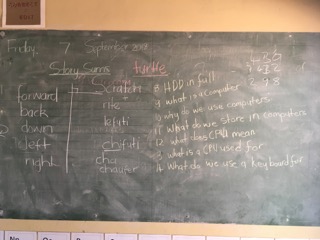

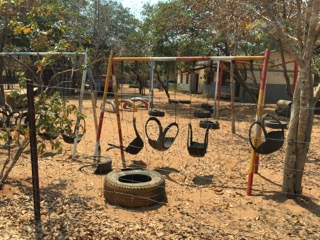
We've all brought gifts for the children (pens, crayons, soccer balls, stickers, etc.) and they in turn have made beaded jewelry for us (which we pay for with donations to the school). It's an inspiring and moving experience (Doug wells up in tears again). [ OK, Doug here: In my defense, I was maybe a bit exhausted and overwhelmed by the whole trip at this point. But, there was something so beautiful about the kids and the dedicated, loving staff in the middle of an extremely poor and harsh (dusty, hot, little water) environment - the sweetness of life and life-giving hope in the middle of what we Westerners would recoil from. The children were bright and energetic and their loving teachers were so kind and gentle. This to me is the essence of Africa. So much light and love and energy in spite of every disadvantage you could imagine. I still well up with tears at the thought of it. ]
From the school we walk to a nearby group of traditional huts. Before entering we must shout out a greeting asking if we may enter, and in reply they formally invite us in.



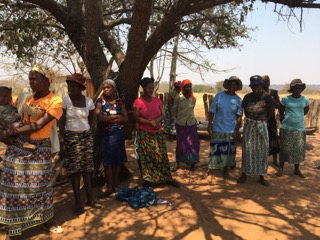
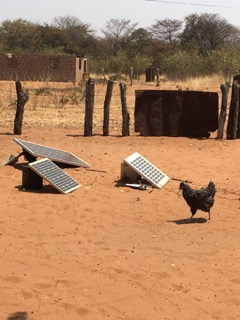
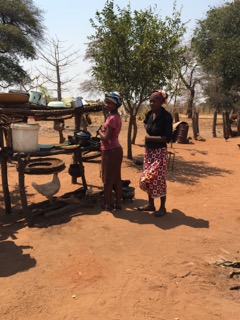

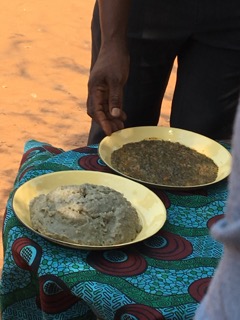

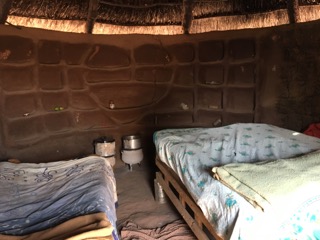
They show us the layout of the place, and graciously allow us a glimpse into their huts. They've been cooking the midday meal, and invite us to have a taste. Paula digs in, grabbing a small handful of the sticky maize meal (which they've ground by hand) that is kneaded to a ball into which the vegetable stew (beans, tomatoes, greens, spices) is pressed. Very tasty!
After this warm embrace by the villagers and schoolchildren we head back to Victoria Falls for lunch at the Lookout Cafe overlooking the gorge of the Zambezi River. Then on to our river lodge and a chance to settle in to our rooms - oh so spacious, after those train cabins! (Of the train accommodations, Doug says he has to leave the room to change his mind. har. )
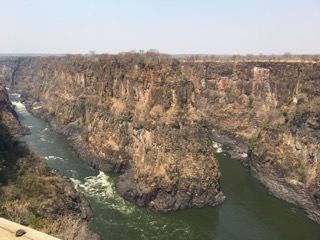


And finally, the climax to this grand adventure: Victoria Falls! We're in a kind of amazement as we walk along the 15 viewpoints to the falls, the spray raining over us in places. The thunderous sound, the magnificence of the sight - it's awesome, in the truest sense of the word. (see/hear attached.) One of the Seven Wonders of the World.
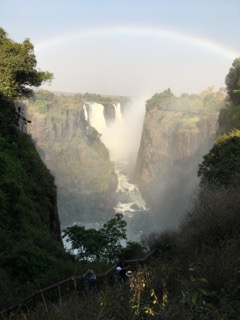
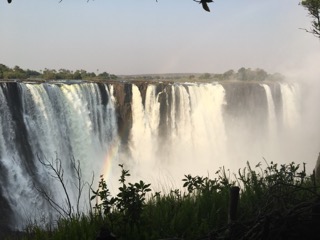
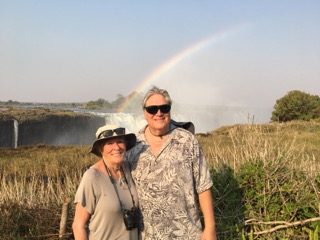
Our farewell dinner takes place on the grass outdoors by the river, to the accompaniment of local musicians. Two of them are playing the "drum piano," below. The larger group sings like Ladysmith Black Mambazo and a couple of us join them in the final celebration. It's a magical night.
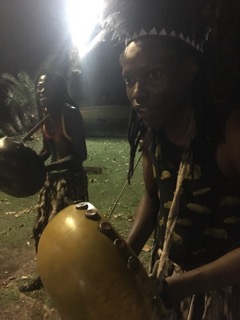
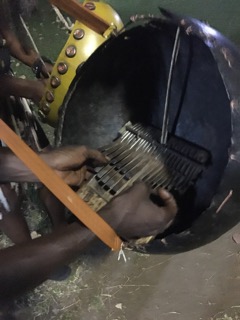
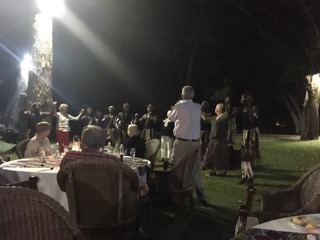
 Farewell Singing (night movie)
Farewell Singing (night movie)
 More Farewell Singing (movie - audio only)
More Farewell Singing (movie - audio only)
10 - On Our Own For 8 Days: Back to Joburg
We've finished our first Road Scholar tour and are now on our own for 8 days. We fly back to Johannesburg, where Doug has scored a super deal at a luxury hotel for two nights of R&R. Good thing, as Paula picks up a bug on the flight (something to do with the chemical the flight attendants spray throughout the plane before takeoff, perhaps?)
Our worries about getting from the airport to the hotel (with its attendant dangers) were for naught, as we are easily able to hop on the fast, modern and comfortable Gautrain right at the airport, which drops us off 20 minutes later - a block from our hotel in Sandton. Sandton is a far cry from Soweto - what a study in contrasts. We feel a little guilty, but also relish the extravagance, just for a day or two! Sandton is the affluent area of the city and boasts one of the largest, most upscale shopping malls - rivaling any in the U.S. - which happens to be right across Mandela Square from our hotel, the fabulous Michelangelo. We venture into the mall that afternoon in search of ibuprofen and are taken under the wing of the gracious and talkative Colleen, seemingly of Indian heritage (Colleen? of India?), who simply insists on personally escorting us wherever we need to go - otherwise we would be hopelessly lost. A random act of kindness.
The next day is Pamper-Paula-and-Doug day at the Michelangelo. Paula indulges in a facial, Doug takes a massage - both from the deft-handed Matilda (Matilda? of Africa?). Doug is deeply impressed with the African style of massage. Then steam baths and Jacuzzi. We dine at the hotel and are treated royally by our engaging server Bheki, who presents each dish that arrives under a silver dome with a ceremonial flourish - most impressive of all is the over-the-top creme brulee that comes in a silver dish oozing dry ice.
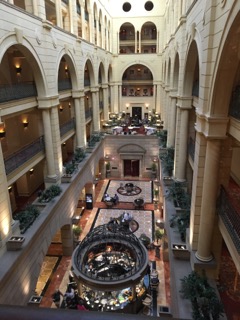
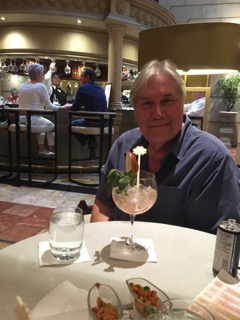
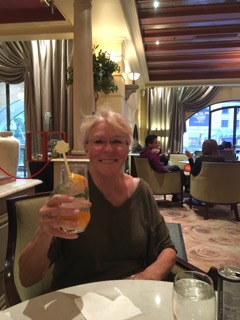
Paula is feeling much better!
Next on the itinerary is Madagascar. We have no idea what's in store for us there.
11 - Madagascar
Mon Dieu! What a place. This is uncharted territory for P-Girl and the Dougster.
First of all, getting here. We are on a South African Airways flight from Johannesburg to Antananarivo (pronounced Ahn-TAH-nah-nah-REE-vo), or Tana for short, the capital city of Madagascar. For the first time ever in all our travels, they won't let Doug on board since the name on his ticket (Doug) doesn't match the name on his passport (Douglas). [ Sound familiar, Pete? ] He must purchase a new ticket! We get this accomplished (and, fortunately, are assured of a refund on the old ticket) and then head to security, where they confiscate Paula's two containers of insect repellant. So far, so bad. Oh well, could be worse. A lot worse.
We arrive in Tana to chaos and confusion. Porters grab at our luggage and try to push us through the shortcut lanes (and demand payment for the service). Bags are thrown on the security conveyor belts and tumble out onto the floor at the other end. People are jostling for position, elbowing their way through the crush of people. We cling to our stuff and forge on. Once through this gauntlet we find our driver/guide, Christian, waiting for us - whew! Doug has had the foresight to interview and hire Christian in advance, and he turns out to be a gem. He's university-educated in hotel management and tourism, speaks English well, and knows his way around. Unassuming and gentle, he doesn't volunteer a lot of information, but ask him any question and he has a knowledgeable answer. Plus, he laughs at all of Doug's jokes.
Getting to our hotel is hair-raising. The traffic is horrendous. It takes us 2 hours to travel 10 miles. But we get an eyeful on the way. We pass ramshackle shops, vendors with their wares on their heads, people doing laundry in the river, and locals tending rice in the many paddies filling the landscape. The local busses (mini-vans) are jam-packed and there's a guy standing at the always-open back door to take money and squeeze people in (kind of like the people-pushers at the Tokyo subway).

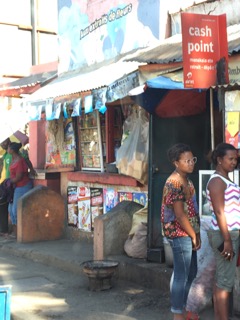
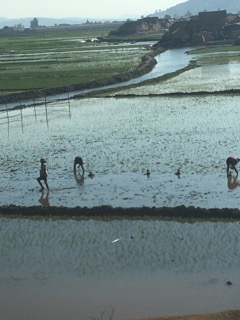
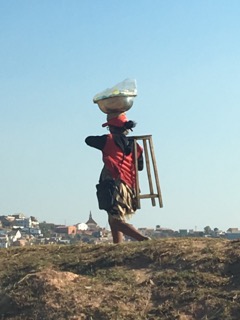
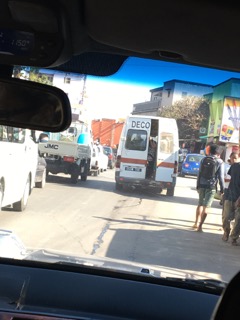
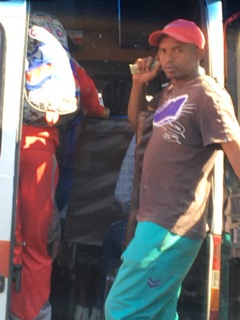
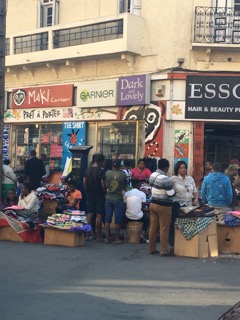
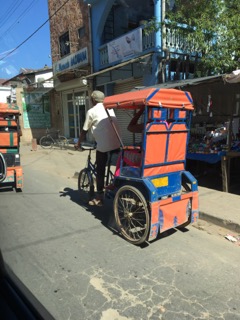
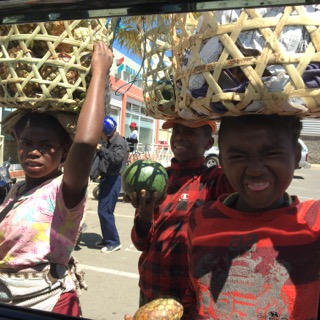
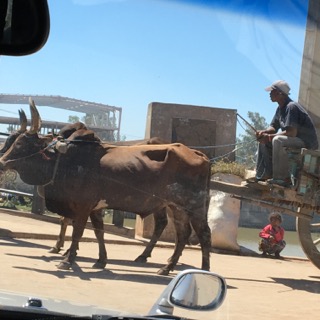
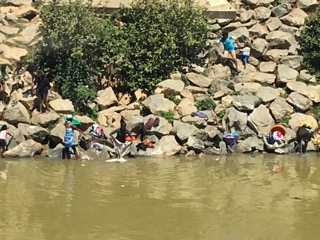
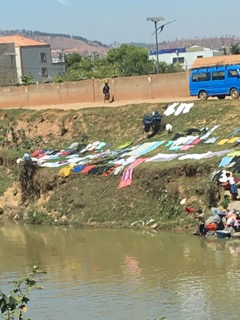
Finally we reach our hotel, the Saka Manga (Blue Cat). Wow - the most exotic hotel we've ever encountered. It's owned and run by a Frenchman and staffed with French-speaking locals. From the outside it looks like a dump, but step inside and a beguiling world awaits. The hotel consists of several structures attached haphazardly by narrow alleys and stairways and is decorated throughout with native artifacts; it's a little museum, really. Our room is huge, with a mosquito net-covered king bed, a sitting room, a desk, a patio and a bathroom with shower and tub. Having been advised not to venture out past 5:30, we stay in and enjoy cocktails (with the resident parrot) on the patio by the little pool then wander upstairs to a lovely dinner.
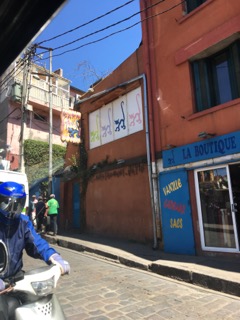
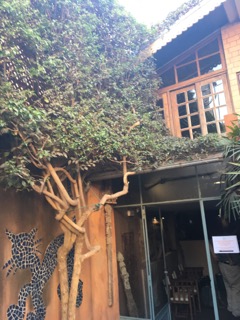
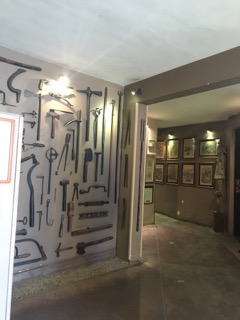
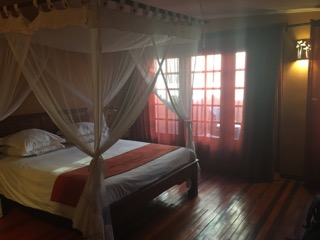
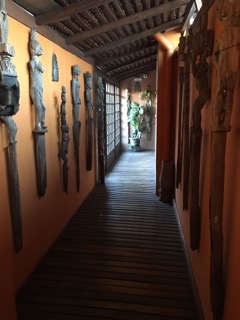
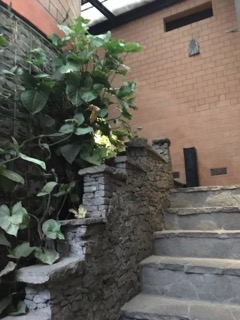
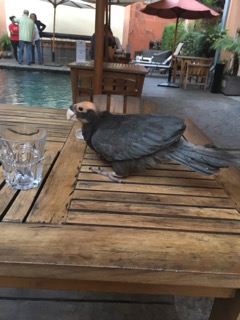
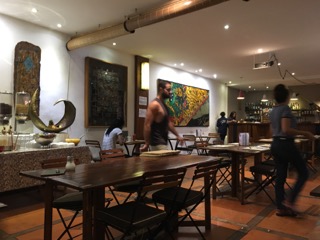
Breakfast the next morning is in yet another pleasant space of the hotel decorated with artwork. Good French coffee and croissants! Christian has persuaded us to do an overnight trip to the Andasibe (pronounced Ahn-DAH-see-bay) National Park, a rain forest in the eastern part of the island, to see the lemurs - a special variety called Indri (also called Babakoto), the largest living lemur, found nowhere else on earth. (Apparently, if they're moved to captivity they go on hunger strike.) We're only too glad to leave the commotion and traffic of the city. Turns out it's a 4-1/2 hour drive over pot-holed roads.
The overnight lodge he has selected for us in Andasibe is quite nice, and we have our own spacious bungalow (for all of $70, including breakfast). He's arranged a night walk for us with a guide - another Christian - in the rainforest where, if we're lucky, we'll see nocturnal animals. We see a woolly lemur, a mouse lemur, a giraffe bug, a leaf-tailed gecko, a stick bug, a tree frog, a chameleon, and a snake. Not too shabby. Paula's only able to capture a couple of reasonable night photos
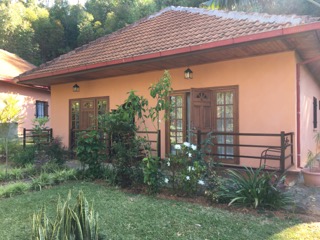
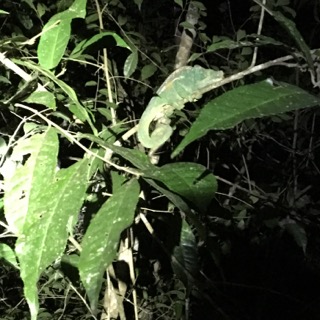
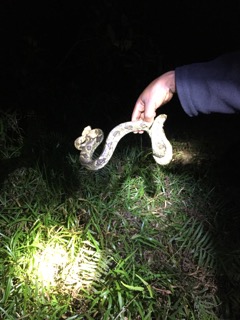
The fourth largest island in the world, Madagascar split from the Indian peninsula around 88 million years ago, allowing native plants and animals to evolve in relative isolation; over 80% of its flora and fauna are found nowhere else on Earth. France invaded Madagascar in the late 1880s and it remained a French colony until 1960, when it gained independence. Malagasy is the name of the native people, as well as the language, which, along with French, is the official language of the country. It is among the poorest countries in the world, acccording to the United Nations. Despite the poverty, luxury tourism has arrived.
Apparently Christian is a common name for local males. Our main guide, Christian, is from the Merina tribe, which inhabits the interior mostly. They are the largest ethnic group and ruling tribe of the island (there are about 18 tribes altogether). Their ancestors came from Borneo, Malaysia, Indonesia, India, Arabia. Other tribes include those from East Africa, who are mostly settled on the coast. We learn that Christian's given name is Heriniaina ( Power of Life ) and the rainforest guide Christian's name is Nasdivina ( Gift of God ). Here they are:
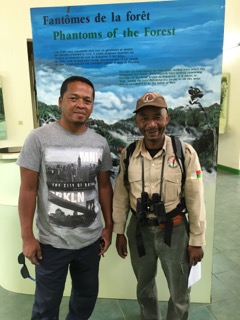
We are not well prepared for the next day's exploration in the forest. We have only sandals; Doug at least has socks but Paula forgot hers; we didn't bring walking sticks. But not to worry. Heriniaina takes us to the local market where he picks out a pair of magic shoes for Paula ($6): a perfect fit. (Paula realizes that she is the only white person in the entire market, but it doesn't seem to be an issue.) Nasdivina makes impromptu walking sticks for us with branches found alongside the path. We're all set.
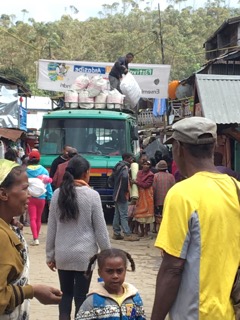
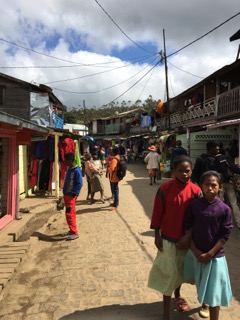
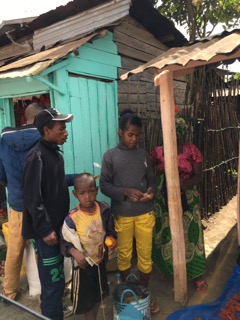
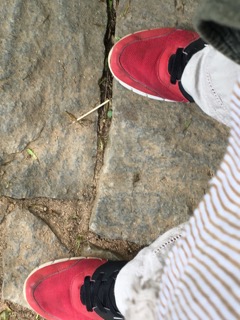
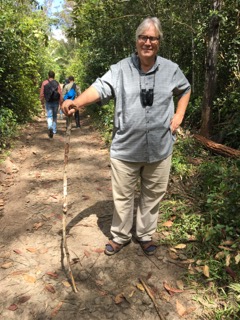
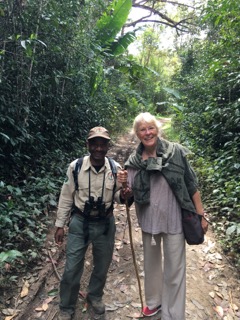
We follow the trails in the park for a while and see brown lemurs, and some beautiful birds: Bulbul, Drongo, Cuckoo Shrike, Blue Kua, Kingfisher, Turtle Dove. Also, the giraffe bug again, which is much better in the daylight. Nasdivina points out the pallisandre tree, a very slow-growing rosewood out of which a lot of the furniture we see is made. Also, the traveller's palm. No baobubs, though - they are in the south of the island.
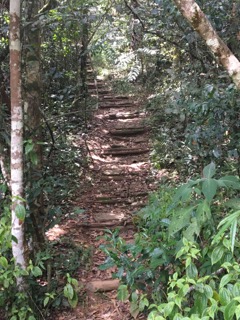
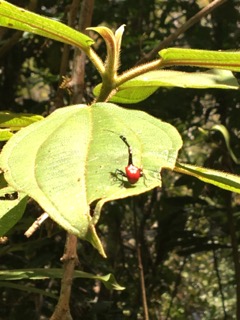
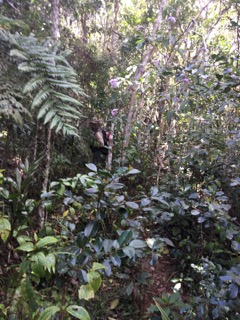
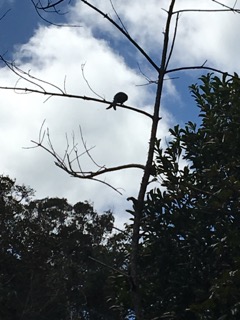
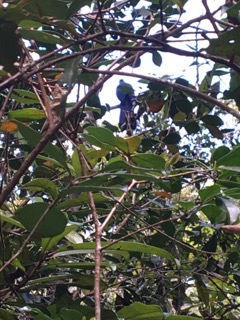
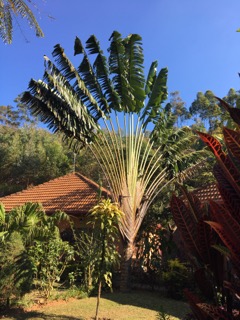
Suddenly we hear loud wailing - the morning call of the Indri! Look & listen:
Nasdivina leads us off the beaten path and we bushwhack to the place where we see a group of Indri in the canopy above. We've achieved our goal. We can't believe we re doing this! What an experience.
After lunch at a local restaurant we head back to Tana, for the 4-1/2 hour return trip. More potholes, but hey - we're used to it now. Along the road we see a wedding party, the brides (looks like there are two of them) dressed head to toe in sparkling white surrounded by revelers ... just walking down the side of the country road as cars and trucks rumble by. Farther down, we see a man splayed out in the road before us, completely unconscious - dead drunk, according to Heriniane. A victim of the local lethal moonshine.
In the next village, Heriniaine notices a celebration taking place in the street. He pulls over and explains: in some tribal traditions, the family and friends of a dead person (typically around 5 years dead) exhume the body from the grave, wrap the corpse in cloth, place it on a pallet and parade singing and dancing through town. They then rewrap the body in new cloth and rebury it. It's a way of maintaining contact with and celebrating the ancestors, as well as bringing the extended family together. Here you go:
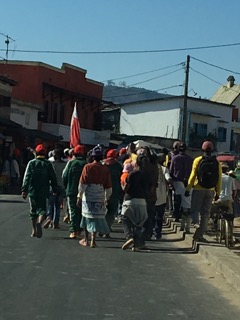
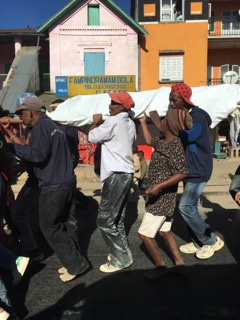
Thoughts? This is our first real experience with the third world. Astonishing. Teeming chaos, professional beggars, no apparent organization, but a pell-mell set of activities that just barely avoid colliding with each other. In the middle of it all, modern cars and big trucks and thousands and thousands of people eking out a living doing whatever they can do. It's life lived in the open. Ox-driven carts in the city streets, and virtually no rules of the road. But nobody seems too bent out of shape; in fact, we see mostly smiling faces.
We're glad we came.
12 - Addis Ababa, Ethopia
Ethiopia - why not? Addis Ababa is the best destination flight Doug can find out of Madagascar, and just a 1-1/2 hour connection flight to Nairobi, where we'll meet our next Road Scholar Tour in 3 days. Definitely worth a visit. It's one of two countries in Africa never colonized (Liberia being the other). By the way, Happy New Year! The Ethiopian calendar has 12 months of 30 days, plus 5 or 6 extra days. The new year starts September 11. There's a gap of 7-8 years between the Ethiopian and Gregorian calendars.
Doug has found another great deal at the Sheraton Addis Ababa, a luxury resort with - you guessed it - a spa, Jacuzzi, sauna, massages, etc.
The Ethiopian women have a distinctive beauty; here's our hostess at hotel check-in.
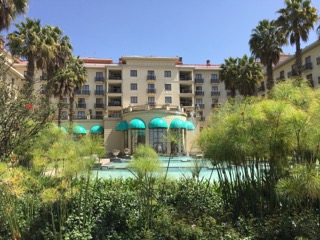
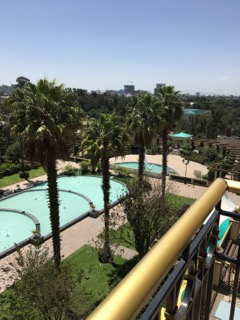

We plan to rest up for our next RS adventure and not do much of anything - which is good, since Paula has got yet another cold from the flight over (even though we find Ethopian Airlines to be superb: the plane, a new 787, is comfortable with plenty of legroom, quiet and smooth. Never mind that we had to go through 9 checkpoints to get to it).
On our second day, we hire a driver to take us on a tour through the city, and hit a couple of the main attractions, so to speak (the city itself is not so attractive). We drive through the frenzied open-air market, then, passing donkeys laden with firewood driven by their tenders, up to Mt. Entoto, which boasts a panoramic view of the city, plus a palace, church, and monastery built by King Menelik II. There is a museum with artifacts of Menelik's life, and the interesting octagonal Entoto Maryam Church. The palace and monastery are rough-hewn and kind of primitive, actually, considering they were built in the late nineteenth century. We get bamboozled into being escorted by a guide (which we assumed was part of the entry fee) only to be pressured into giving him a tidy fee at the end. This happens frequently, where people insert themselves into your lives to perform some small "service," then demand payment. We then visit the National Museum, whose highlight is the paleontological exhibit in the basement, home of the world-famous Lucy, discovered in 1974 in northwestern Ethiopia. We head over to Trinity Church, where Haile Selassie is buried, but decide not to battle the crowd assembled there for a funeral. Selassie was Ethiopia's regent from 1916 to 1930 and then emperor until 1974. Born Ras Tafari Makonnen, he is believed by as many as a million rastafarians to be the returned messiah. Did not know that.
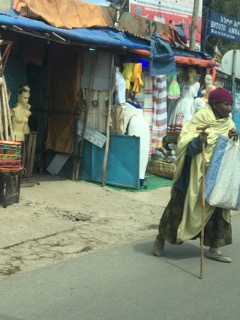
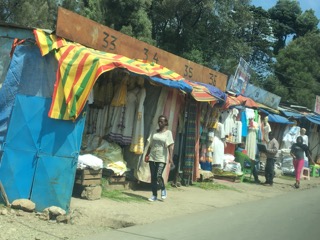
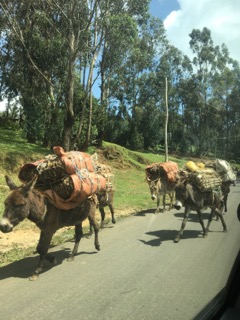
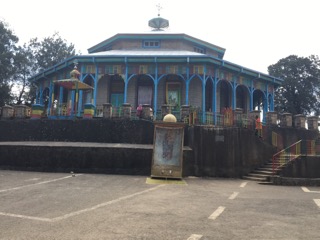
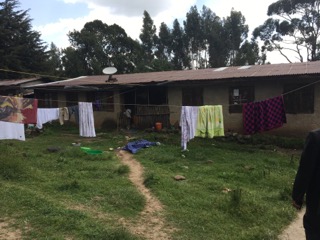

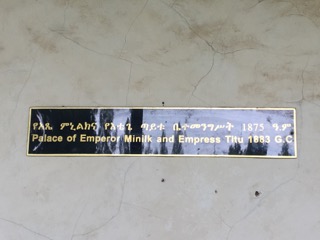
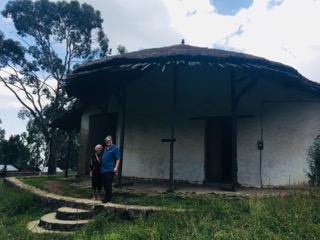
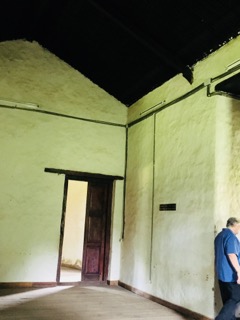
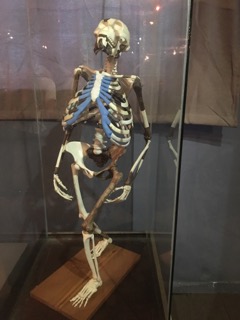
That night we are invited to join a new friend, Lulseged Retta (whom Doug met at the Jacuzzi earlier) at the hotel's nightclub to hear some local jazz. We are particularly taken by this music:
Turns out, our host is an international artist and coordinates the art for the hotel and other venues. And a popular guy at the club - he seems to know everyone. The bass player comes over to chat and we learn that he studied music in Boston and knows a couple of musicians that Doug knows. Small world!
So now we're headed back to Nairobi to join our second Road Scholar tour: a classic safari in Kenya and Tanzania for 12 days. We will definitely not have internet access and will leave our laptop behind in the hotel to pick up when we return.
Thus ends the chronicle for now! Cheerio.
13 - Classic Safari in Kenya & Tanzania
We arrive in Nairobi and make our way to the Eka Hotel where we will meet our next group of Road Scholars. Here's where we realize we are supposed to have soft-sided duffel bags for the upcoming trip, since all the luggage has to be squished into the tight spaces of our safari vehicles. Luckily, there is a shopping center across the street and we pick up a second duffel (we already have one), as well as restock toothpaste, moist towelettes, and cough drops for Paula. (No luck on the insect repellent; we are supposed to get one with a high concentration of Deet, but Kenya has banned Deet. We'll have to rely on the supplies of our fellow travelers. As it turns out, though, we only need it once, when we're in tse-tse fly territory.) We pare down our wardrobe and supplies and repack into the two duffels, leaving our roller suitcases at the hotel for pickup on our return.
While the hotel is generally pretty nice, for some reason we are given a room with the Chinese bed option that is hard as a *bleep*ing rock. On top of that, the air conditioning doesn't work. Which puts Doug in a fit of pique. Needless to say, he is in a funk the next morning. If he had any apprehensions or misgivings about this trip, he now has them in spades. Not an auspicious start to this leg of our adventure!
We meet our group at breakfast. There are 12 of us: 9 women and 3 men, plus our guide, Washington. He looks so young! Yet he is impressively accomplished. Born and raised in Kenya, he has two degrees in Environmental Science and Animal Ecology; has written articles and books - especially about birds, his specialty; is a filmmaker and nature photographer; and has given a TED Talk (see: https://www.ted.com/talks/washington_wachira_for_the_love_of_birds#t-27420). We're in good hands.
This group consists of retired schoolteachers, librarians, social workers (women) and an engineer and accountant (men). Over the course of the trip, Paula can't help but observe the similarities they share (appearance, personality, mannerisms) with people she knows, such as:
- Sue and Karen from Ohio. Kathleen from book group could be Sue's twin, and Judy from Harvest Market is Karen's lookalike. They are the chattiest among the group. Sue the social worker is also a daredevil skydiver. Karen gets the safari fashion award - wardrobe and makeup category.
- Susan and Barry from Colorado. Susan is a dead ringer for the Migrant Mother pictured in Dorothea Lange's depression-era photograph, with a personality to match. Barry could be Steve-from-our-last-RS-trip's brother. The bearded crew-cut silent type. We barely exchange two words with them during the entire trip.
- Carol from Iowa. A female Tommy Lee Jones just about sums it up: craggy. Of all our fellow travelers on the two RS trips, she is probably the one with whom we have the least in common. She doesn't seem to share interests with her husband; she's left him behind. Polite avoidance seems to be the best strategy.
- Richard from Washington. Think Cameron from Ferris Bueller's Day Off (Alan Ruck). A real travel veteran (this is his 7 th continent). Introverted, but interesting if you probe.
- Emily from Claremont, CA and Vermont and her friend Robin from Iowa. Emily could be Barbara Streisand's shy vegetarian peacenik older sister. An avid birder. Robin has Annette Bening's exact voice and smile. Kind, with a love of music; her husband was a musician and conductor and her two sons are jazz musicians.
- Jean from Palo Alto. Brings Mitzi to mind, only with red hair and freckles and a permanent vocal fry. Wry wit; independent.
- Lynn from Ohio. Could be Michael Moore's mother, with a better haircut. Gets the safari photographer award. (Paula is jealous of her 600mm zoom lens, capable of capturing birds and animals in the distance.) Good sense of humor.
We pile into our two safari vehicles, 6 of us in each, plus the drivers and Washington. They are Toyota minivans with pop-tops (open-sided and open-roofed safari vehicles are not permitted on the roads). We find ourselves seated with Robin, Emily, Jean, and Lynn; the others are in the second van. Before too long, we are comfortable with each other and secure in the conviction that we are the cool group.
On our way to Amboseli National Park, we pass stands along the road offering onions and tomatoes, as well as vendors on the median strip in the middle of traffic hustling slingshots (for fending off monkeys), sugar cane, thatch materials, mirrors, coat hangers, and other odd assortments of items.
Turns out, our Madagascar road trip was good preparation for our road experiences over the next two weeks: most of the roads we travel are unpaved and BuMpY. Our program is rated "active" not because of physical activity, but because of long rugged drives over unpaved terrain. (In the Serengeti, Emily's Fitbit tracks 22,263 bumps in one day!)
14 - Amboseli National Park
After our 4-hour bumpy ride, we arrive for lunch at Kilima Safari Camp just outside the entrance to Amboseli park. We are lodged in cabins that are actually luxury tents with electricity and running water, shower and toilet - quite lovely and comfortable. The good news: after a good night's rest, Doug's spirits are restored.
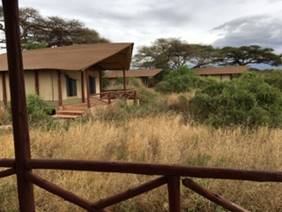
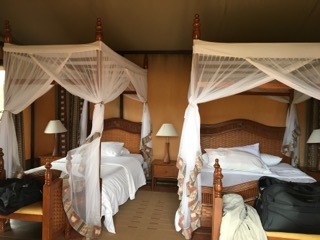
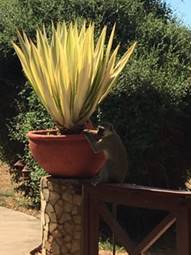
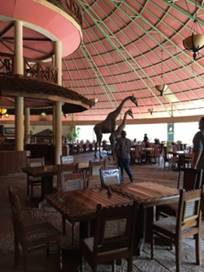
We spend the afternoon and next day on game drives in the park. Our vehicles leave something to be desired, as they are a bit the worse for wear and admit a LOT of dust, through the windows, floors, pop-top, and who-knows-where. (Amboseli means place of salty dust. ) For the best view, you must stand and look out the pop-top (not easy if you're in the back row of seats). Paula is longing for a Land Cruiser like the ones she's noticing navigating the park.
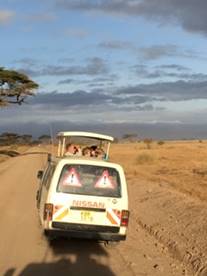
But we do see a ton of animals: elephants especially, and wildebeest, lions, ostriches, zebras, Thompson's gazelle, Grant's gazelle, warthogs, caracal, baboons, mongoose. And oodles of birds: cattle egret, lilac breasted roller, banded martin, crowned lapwing, white bellied bustard, red billed buffalo weaver, wattled starling, white egret, helmeted guinea fowl, jacana, blacksmith lapwing, grey crowned crane, Egyptian geese, great white pelican, African spoonbill, blackwing starlet, wood sandpiper, white faced whistling duck, African fish eagle, glossy ibis, blackwing stilt, long toed lapwing, spur wing lapwing, eagle owl, leopard faced vulture and a huge convention of pink flamingos!
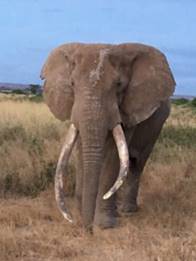
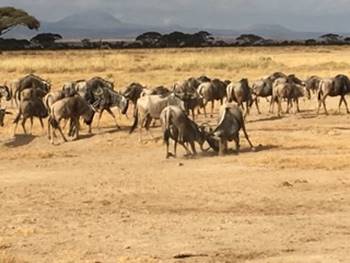
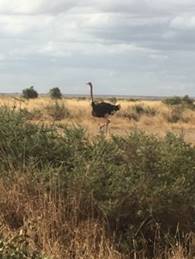
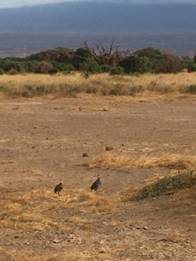
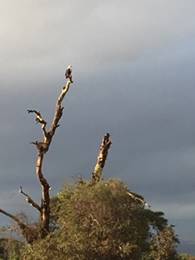
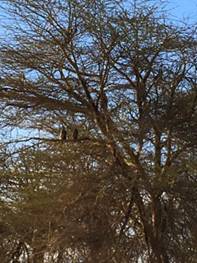
 Elephants Crossing Road (movie)
Elephants Crossing Road (movie)
 Animals on the March: Baboons (movie)
Animals on the March: Baboons (movie)
 Animals on the March: Elephants (movie)
Animals on the March: Elephants (movie)
Highlights are an extensive elephant family huddled around a young elephant lying on the ground (we're curious as to what's happening there), gazelles locking horns in contest, and the elusive caracal. Best of all, we get a beautiful view of Mt. Kilimanjaro - the tallest freestanding mountain in the world - when the clouds open up around it. We're told that Kilimanjaro is really misnamed; it should be Mlimanjaro. Kilima means hill, while Mlima means mountain. Njaro is Swahili for whiteness. So the name means White Mountain, for the snow on top.
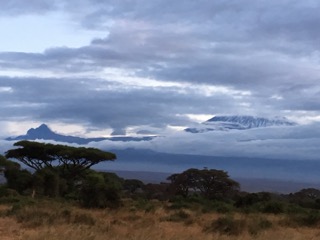
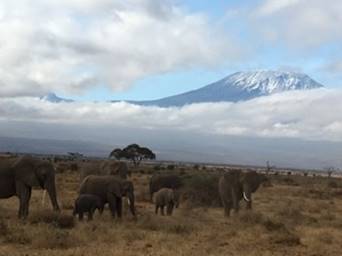
David, our driver (Chagga tribe, native name Daudi), is great at spotting and pointing out animals and getting us a good view. Once we are fulfilled, we learn to say sawa sawa - Swahili for OK - indicating we're good to go. Hakuna matata is an oft-repeated phrase and Lion King references abound. The name for lion is actually Simba, so there you go.
Back at camp, Washington gives us a lecture on the groups of tribes of East Africa: the Bantu (the largest group, which includes the Kikuyu - Washington is from the Kikuyu tribe); the Nilotes (which include the Luo - Pres. Obama is from the Luo tribe - fisherman who live around the gigantic Lake Victoria); and the Cushites (more Arabic than African, found in Ethiopia and Somalia). Kenya has 42 tribes, and Tanzania has around 120 - each with their own language. He gives us a special look into the Nilotic Maasai culture, the only tribe of the 42 in Kenya that has preserved their traditional culture. A semi-nomadic people, the Maasai (so called after their particular speech, Maa) are now found only in southern Kenya and northern Tanzania (having been granted pasturing and grazing rights to the national parks there), and are famous for their reputation as warriors and cattle rustlers. They believe that God gave them all the cattle on earth, so that raiding cattle from other tribes is merely a matter of taking back what is rightfully theirs. They are apparently also noted for their pride and arrogance. (Paula is currently reading Peter Matthiessen's book The Tree Where Man Was Born, in which he observes the Maasai have an unquenchable sense of their own aristocracy, and won the admiration of the whites by looking down on them.) Their diet consists of a milk and blood mixture, and meat. You can recognize them by their traditional dress of red tartan fabric, their stretched earlobes, two missing lower teeth (extracted deliberately), decorative beads and silver jewelry, and ever-present staff. Or, in the case of just-circumcised teen boys, their black cloaks and ghostly chalk-painted white faces. Startling to come upon at the side of the road as we drive by!
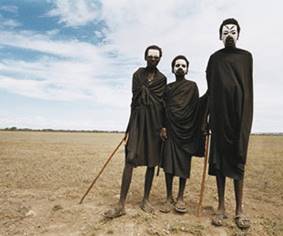
We are invited to join a nature walk at Kilima Camp conducted by a rather pompous Maasai guide, Kerika, and his mysterious silent companion Tipopo. While not all that instructive (aside from learning about the teeth-cleaning properties of a local plant, and the nest-building habits of the local birds), it's a table-turning experience, being the recipient of a condescending attitude - perhaps what it must have felt like for the native Africans to be lectured to and patronized by the intruding whites. The experience sinks in.
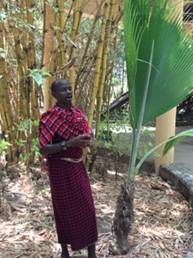
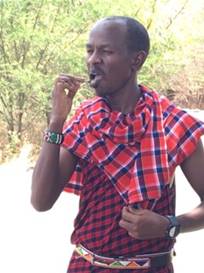
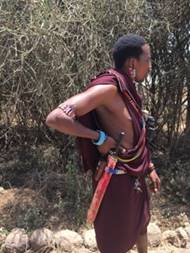
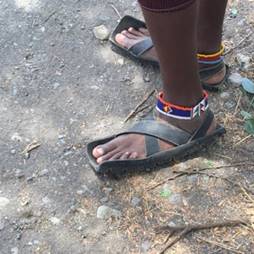
And to round out the lectures, we hear from Livingstone, who gives us an overview of the Amboseli National Park history, tourism, and challenges; info on the various animal habitats savannah grasslands, acacia woodlands, and swamps; and insight into the complex social life and amazing acoustic and seismic communication skills of the majestic East African Elephant.
Then it's off to shower: every nook and cranny of our bodies and hair are caked with dust!
15 - Arusha and Lake Manyara
After a 3-hour ride on a bumpy/dusty dirt road, we cross the border into Tanzania and change vehicles. Hooray! Land Cruisers! Great improvement. And, the roads are decent.
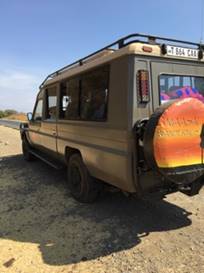
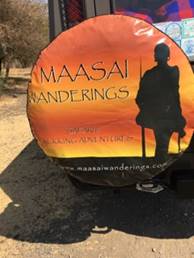
Arusha is known as the gateway to safari destinations, located at the base of Mt. Meru. On the way, we stop at the Matim Primary School. Unfortunately, there are no students as it's a Saturday, so it's quite a different experience from the school we visited in Zimbabwe - but we meet with the principal and school leader. The school is government-funded, but 70% of their resources actually come from private groups and individuals. (The tour company operating our safari vehicles, Maasai Wanderings, is a key supporter.) To entice the children to attend, the school offers a free meal; otherwise they typically have only one meal a day. They have over 1000 children, but only 18 teachers. Nevertheless, they persist.
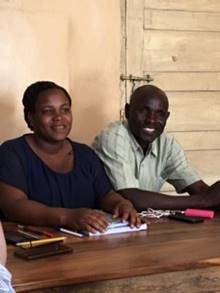
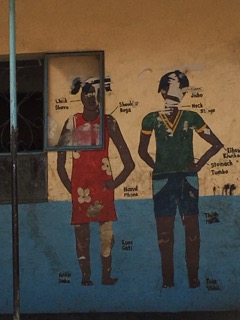
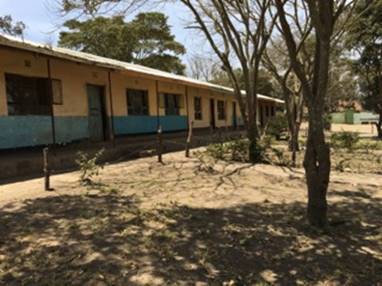
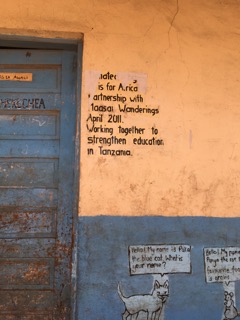
Lunch is at the Kimemo Lodge and Coffee Plantation, a lovely tranquil place in a gardenlike setting with its strong colonial British vibe. The proprietress, Sarah, gives us an education in coffee growing, harvesting, roasting and brewing. Newsflash: because of the way it's brewed (with such a short length of time in contact with water) espresso actually has very little caffeine! For the most caffeine, give it 4 minutes in a French press. It's kind of a Karen Blixen experience: an independent woman running a beautiful, elegant coffee plantation on her own.
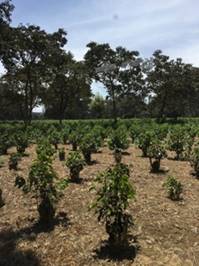
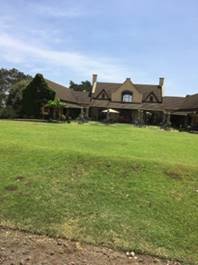
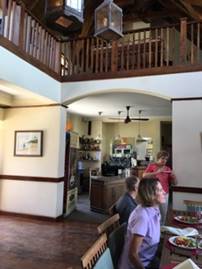
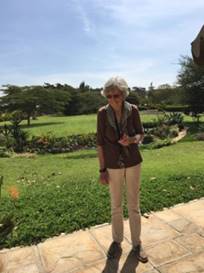
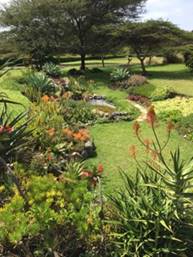
Then it's on to the Arusha Planet Lodge, which is like a paradise after the dry and dusty journey. (It's a pleasant surprise to find hot water bottles warming our beds in the evening.) A local guide, Sirili, gives us a lecture about Tanzania, history, tourism, and conservation. First settled by Arabs, then Germans, then colonized by the British, Tanzania became independent in 1961. Its first president, Julius Nyerere, a humanist and teacher, governed for 23 years. According to Sirili, Nyerere's accomplishments included establishing Swahili as the national language, which served as a uniting factor; fostering a spirit of humanism and racial equality; setting aside 1/3 of the country for wildlife and tourism, and saying no to mining; and setting term limits on the presidency (two 5-year terms). He was not popular in the US, though, because of his emphasis on socialism; but he is held in deep respect in his own country. In 1964 Tanganyika was unified with Zanzibar to form what is now called Tanzania. We're told it's the most stable country in southern Africa. And, it has the highest use of mobile phones! An important innovation has been the use of mobile banking, where money can be transferred via text-based transaction. It's made a huge impact on economic development.

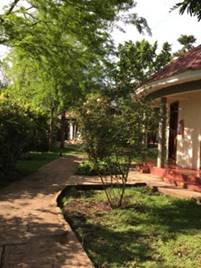
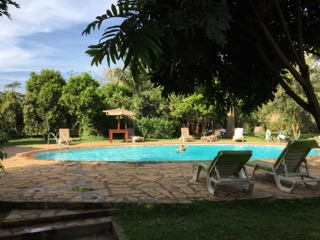
The next day we head to Lake Manyara through the baobab tree countryside. The baobab tree is Africa's iconic tree of life - a prehistoric species (predating mankind and the splitting of the continents) that can live for up to 5,000 years. It's also known as the upside-down tree because when bare of leaves, the branches look like roots sticking up into the air, as if it had been planted upside-down.
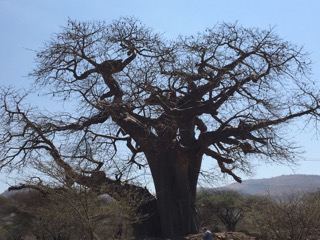
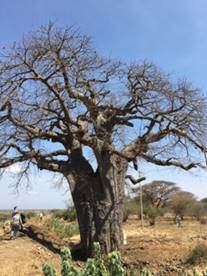
Manyara National Park is rich in wildlife: elephants, hippos, birds, baboons, giraffes, zebras, vervet monkeys. And birds: yellow-collared lovebird, silver-cheeked hornbill, African harrier hawk, saddle-billed stork, sacred ibis, black heron, jesus bird, pink flamingos. While Lake Manyara is famous for its tree-climbing lions, we don't get lucky in that department.
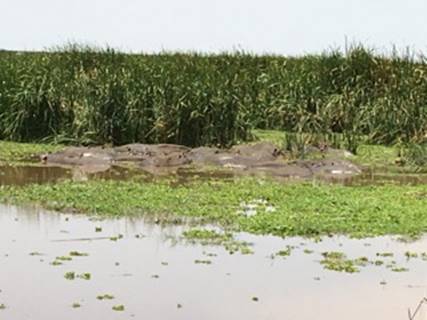
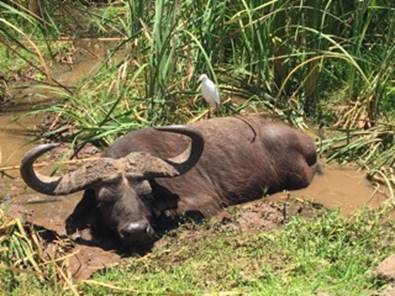
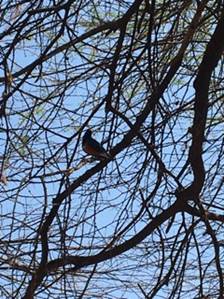
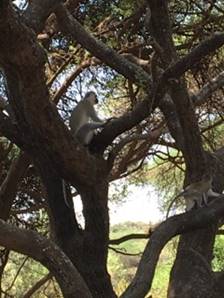
Our last stop before crossing the Great Rift Valley is an arts/crafts gallery that specializes in tribal art and tanzanite, a deep blue gemstone, one of the rarest in the world. Sue and Karen turn out to be skilled negotiators as they both bargain for earrings.
16 - Ngorongoro Crater and Olduvai Gorge
A World Heritage Site and one of the Seven Natural Wonders of Africa, the Ngorongoro Crater (caldera, actually) was named by the Maasai after the sound produced by the cowbell ( ngoro ngoro). It's the world's largest inactive, intact and unfilled volcanic caldera. The crater was formed when the volcano exploded and collapsed on itself 2-3 million years ago.
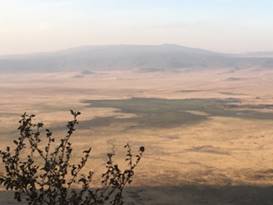
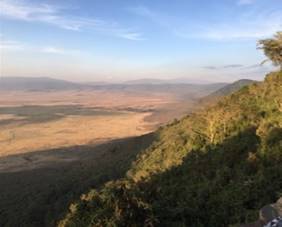
We drive to the rim where we stop for two nights at the Serena Safari Lodge. It's a gem of a hotel in a beautiful setting, built with local river stone and camouflaged with indigenous vines designed to blend completely into the landscape. The walls of our room are decorated with stylized prehistoric cave paintings, and the view of the crater from our balcony is breathtaking. That night we are treated to entertainment by local acrobats before heading to dinner.
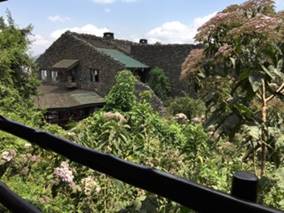
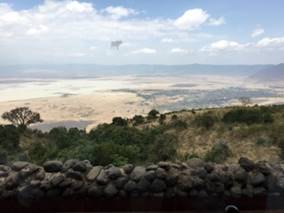
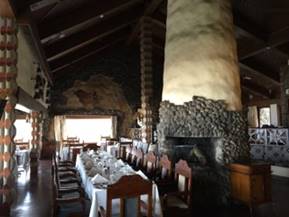
The next morning we're off on a game drive through the crater. Though we don't catch a glimpse of the resident endangered black rhino, we do see some astonishing sights: two post-coital jackals stuck together; a male ostrich dancing for the female - the most hilarious spectacle ever; a wondrous migration of wildebeest and zebras, as far as the eye can see; and two lions strolling on the road alongside our vehicles. We have the afternoon off, which Paula is grateful for, since her cold has now developed into bronchitis. (The clouds of dust we inhale haven't helped.) Washington contacts a doctor who pays a personal visit to our room and confirms the diagnosis, dispensing antibiotics and medicine (for all of $10, plus his charge of $40). He's come an hour's distance and couldn't be kinder or sweeter. Paula is able to rest and recover; Doug sends a tray with chicken soup from the dining room, and takes videos for her of the Maasai singing and dancing that evening. In no time, Paula is feeling right as rain.
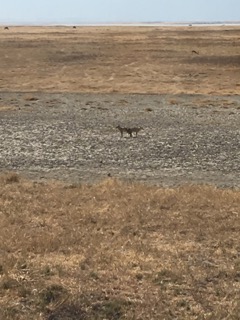
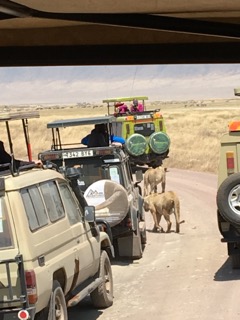
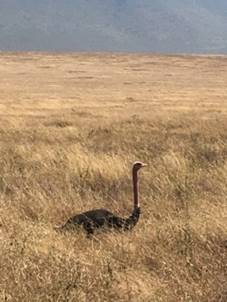
Two jackals, two lions, ostrich
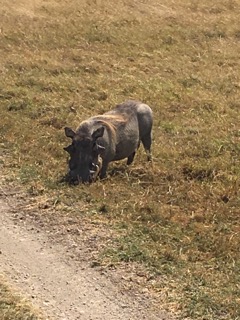
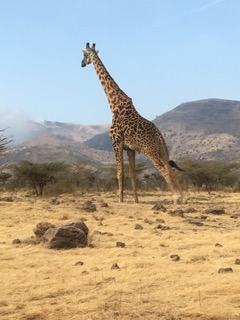
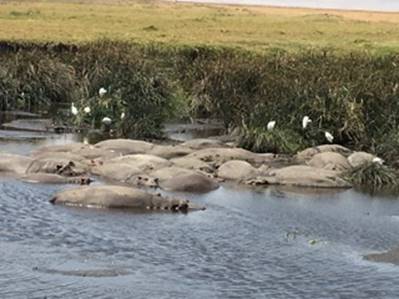
Warthog, giraffe, hippos
 Migration across a river(movie)
Migration across a river(movie)
The Olduvai Gorge in the Great Rift Valley is one of the most important paleo/anthropological sites in the world, where Louis and Mary Leakey made their historic pioneering excavations of the earliest known hominids. Olduvai is a misnomer, we're told; it should be Oldupai, the Maasai word for the wild sisal plant. We visit the Olduvai Museum where we're given a lecture on the place, then are taken down to the excavation sites. The guide shows us fossils and bones of various animals and we hold rocks that were once held 3.5 million years ago by australopithicus boisei, or zinjanthropus. Chills go up and down our spines.
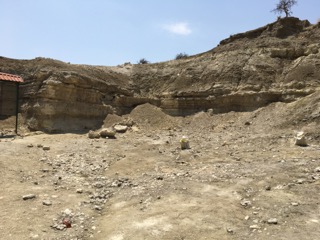
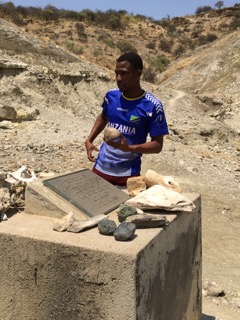
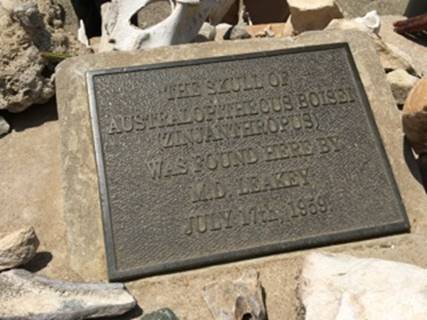
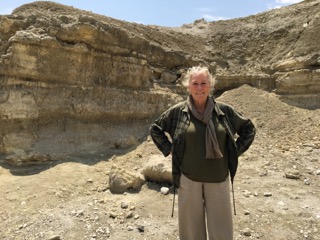
Serengeti means "endless plains", and for good reason. It is overwhelmingly vast. There is no evidence of civilization or human activity, save the dirt roads we're on. No utility poles or wires, no fences, no plastic litter. Just earth and sky, animals and birds. Except for perhaps a solitary Maasai walking in the distance.
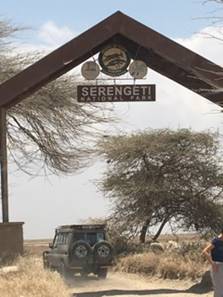
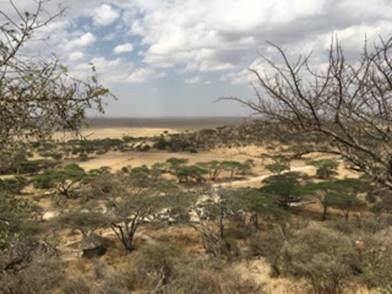
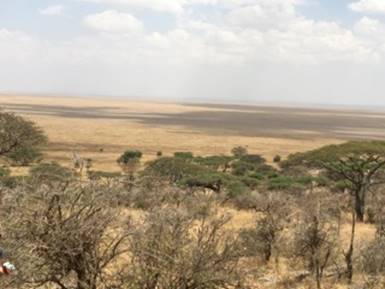
It's almost mesmerizing, bouncing along in our Land Cruiser past eland, topi, hartebeest, lion, waterbuck, dik dik, hyrax, spotted hyena, giraffe, hippos. Washington points out the grey heron, Tanzania red hornbill, superb starling, avocet, white bellied canary, maribou stork.
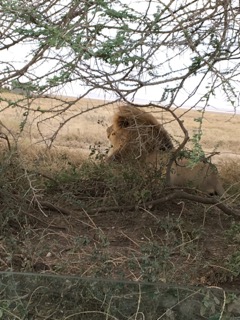
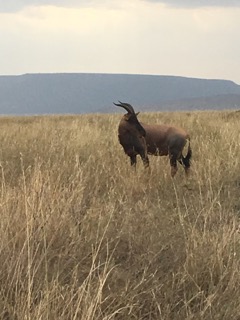
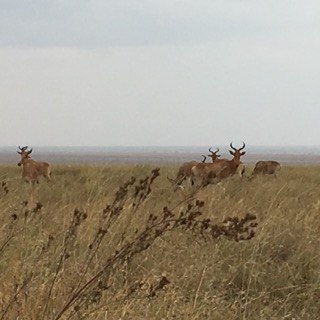
Our camp is in the middle of the Serengeti, amongst the animals. (We can hear the hyenas in the night, and the dawn chorus of birds in the morning.) It's the most rustic of all our accommodations, but with flair: each tent has a comfortable bed with down comforter, oriental carpets, and a chandelier. We have our own bathroom with sink, toilet and shower. Hot water is available on request, and the electricity is turned off at night.
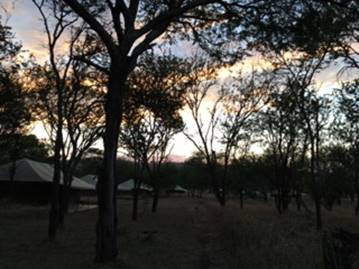

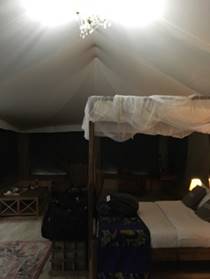
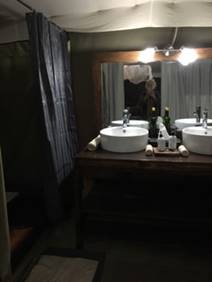
We're up at dawn for the next day's game drive, and come across a lion kill. We only see the leg of the lioness sticking up in the air, almost playfully cat-like, as she gorges on the zebra. A torpid lion snoozes nearby. An elephant herd comes into view, and we notice a big male flirting with a couple of females. He s ready for action! And how. Think of a giant PVC pipe. Now, don't think of it.
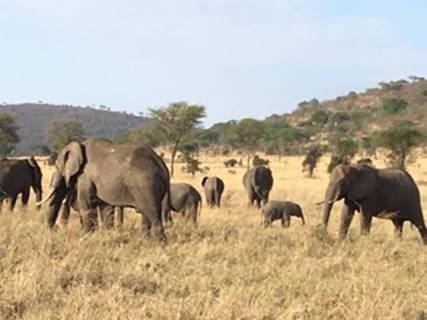
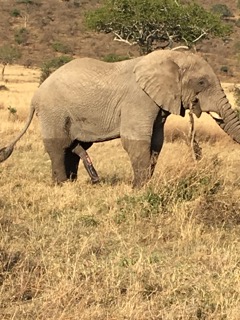
We stop for a picnic lunch at the Serengeti Visitor Center, and marvel at the buffalo weavers building their nests in the trees. A bunch of hyraxes harass us at our picnic tables - creepy smelly giant rodents - but we're told they're good eating. Yuck. We are given a guided tour of the "Circle of Life" exhibit at the center by an intern who is not only completely unintelligible but also offers next to no information aside from what is already written in the displays. But we are nothing if not polite, and nod indulgently when he says "understand?"
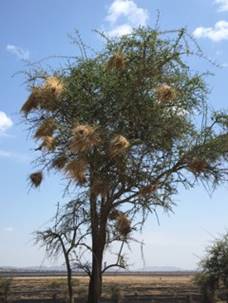
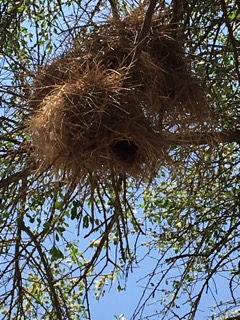
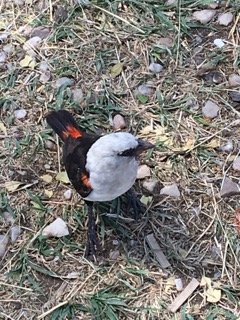
Back out on the plain, we are on the lookout for leopard (to check off our big five list) and Washington and David are keen to oblige. They chatter on in Swahili, discussing strategy. The language is musical to the ear and is punctuated with languid expressions of "eh" "ah" "aia" in their deep voices. After a time, we notice a bunch of vehicles stopped by a tree; reports of a leopard sighting! We join the crowd and, while Washington thinks he spots it, no one else has any luck. Before too long there are at least 30 vehicles pulled up at the site. We wait and wait. Meanwhile, we entertain ourselves by inventing new amusing bird names. An hour passes. By this time, we are all ready to say sawa sawa and be on our way, and we finally convince Washington to give up the effort.
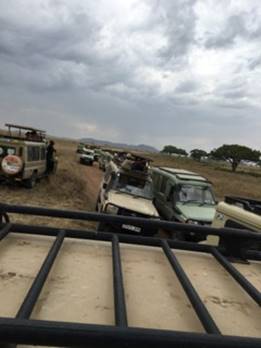
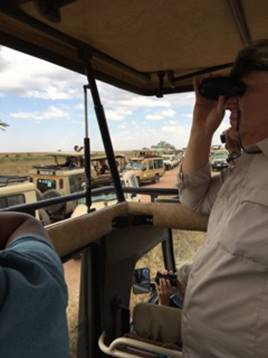
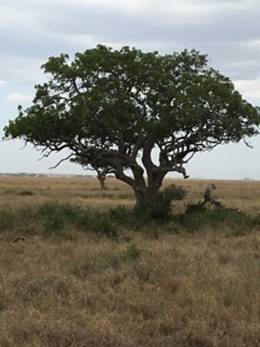
We head to our base, the Naona Moru Camp, but first we have to go through the whistling acacia forest home of the dreaded tse-tse fly. Its bite really hurts. Then you get sleeping sickness. Windows rolled up; pop-top closed down. Jean panics as she swats away a fly. Washington comes to the rescue and squashes the blood-engorged demon (not her blood, thankfully). Finally, as we're almost back at camp, Washington spots a leopard in a tree! Success! Our Big Five list is complete. Washington is pleased knowing he has delivered the goods. (But alas, Paula doesn't get a photo!) We are happy to call it a day; it's been an 11-1/2 hour game drive and we're exhausted.
That night at dinner, the camp crew file in singing Hakuna Matata and showing off their dance moves. We adjourn to the campfire to gaze at the constellations in the Southern sky.
Intermission - Funny Bird Names
I mentioned in the Serengeti email that we entertained ourselves by thinking up funny new bird names. I will copy them here for your amusement, but please note that, out of courtesy, the Republicans in our midst are not included on this email! J Because our group has been following Trump's shenanigans and the Republicans' latest fiendishness with a mixture of hilarity, incredulity and outrage, we came up with a new genus:
Glossary of New Bird Names of the Genus Trump
The narrow-minded Nincompoop
The foul-mouthed Pussygrabber
The Trump-bamboozled Rightwingnut
The venom-spewing Clintonhater
The truth-denying Hoaxwarbler
The Koolaid-drinking Foxnewswatcher
The petty Snipe
The power-thirsty Swampdweller
The MAGA-hatted Laughingstock
The flag-waving Peckerwood
The orange-crested Twit
The slack-billed LieWeaver
The cold-hearted DREAMdasher
Feel free to add your own!
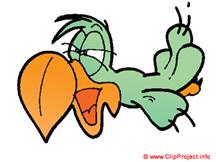
18 - Lake Victoria and Maasai Mara
The camp crew line up to wish us a fond farewell as we depart for Lake Victoria, the world's second largest freshwater lake (after Lake Superior). The lake was discovered (or at least documented) by the explorer John Hanning Speke as the source of the Nile River.
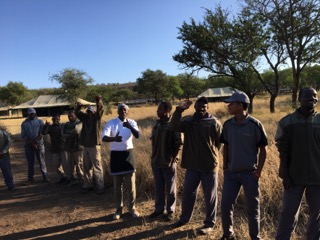
On the way, we pass a monkey nursing her baby, a lone lion in the distance, a cheetah, and hippos galore. Whew, stinky!
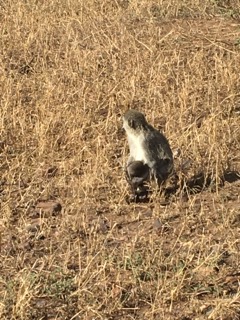
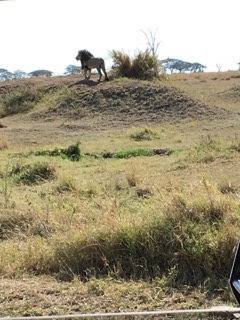
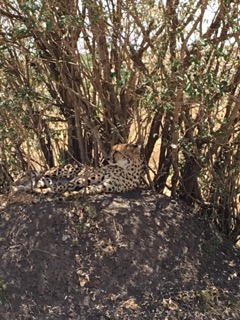
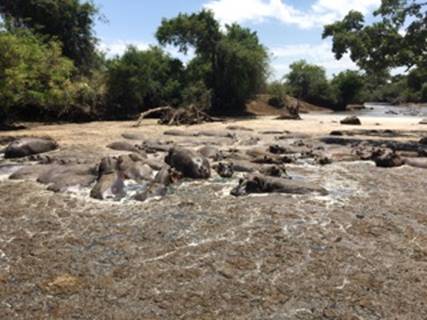
Our fearless leader, Washington, and our two drivers, David and Emmanuel:
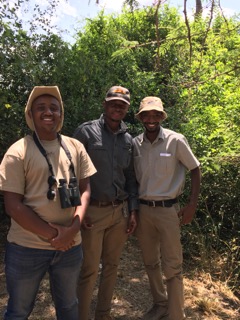
We settle at the Speke Bay Lodge right on the shores of the lake. It looks like a small village, with round thatch-roofed huts (solar-powered) scattered throughout the property, with flowers and greenery. Everything is very well designed and tasteful. We can hear the water lapping the shore outside our hut. Late in the afternoon, we are surprised by dramatic thunder and lightning and a warm rain. Most welcome. The Dutch owner lives there, and joins us for drinks and conversation. He muses that Africa is not the Garden of Eden where animals and people live in sweet harmony, but is instead a world of fear and death, interrupted by the surging pulses of new life. A deep truth. We wish we could stay another night! But we must leave the next morning for the Maasai Mara.
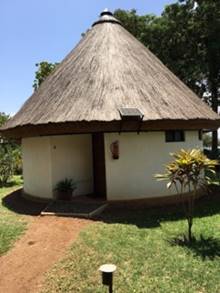
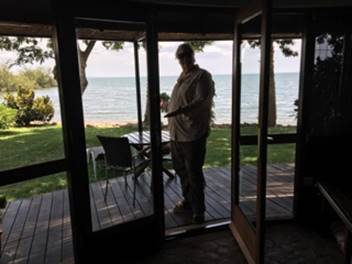
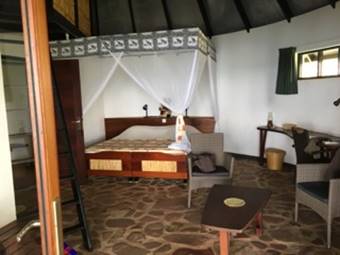
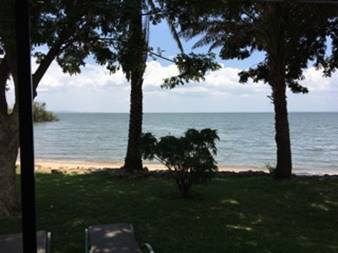
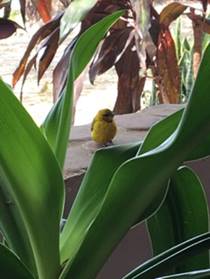
Listen to the birds as we walk to breakfast:
To get to the Maasai Mara, we board a 12-seater bush plane (Cessna 208) for the 45-minute flight. At the Keekorok airstrip, we bump into another Road Scholar group that is two days ahead of us on the same program; they are heading back to Nairobi. We chat with a couple who turn out to be from Novato!
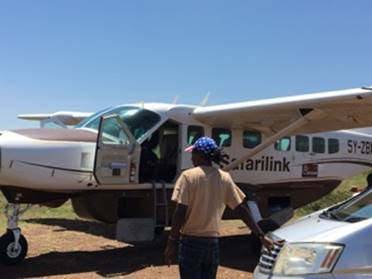
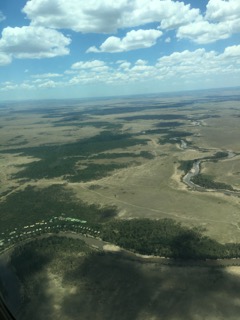
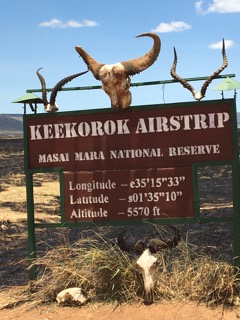
En route to the Fig Tree Camp in the Maasai Mara, we see a bunch more animals, including a cheetah, and a lioness with her three cubs. After lunch at the camp, which is situated on the banks of the Talek River, we're back out on the Mara for the afternoon game drive. The Mara game drives are probably the best of the trip: over the afternoon and next day, we see a lion kill, a lioness and her three adorable cubs out for a walk, a hippo fight in the river, a mama zebra chasing her straying baby and honking in exasperation, a horny elephant chasing another elephant and mounting her, a cheetah and cub, giraffes and their babies, an ostrich doing its crazy dance while chasing a female, and best of all, the endless wildebeest/zebra migration making the dangerous crossing over the Mara River.
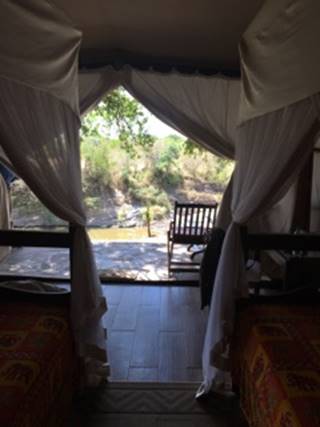
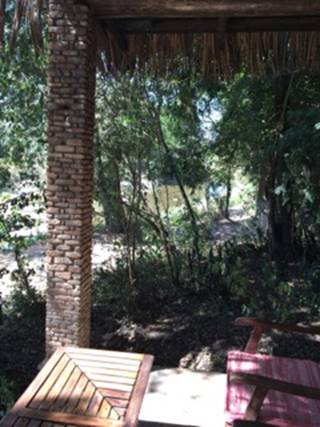
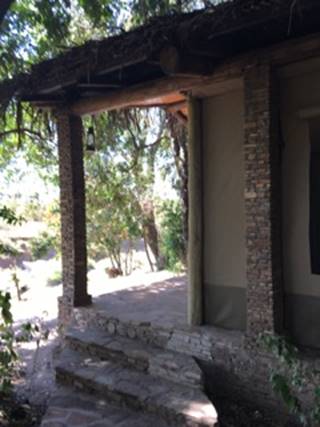
It's a beautiful sunset
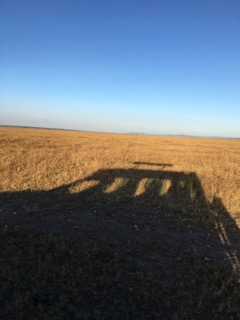
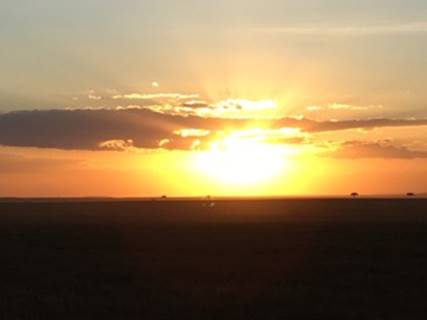
We are given a lecture that evening by Nickson, a Maasai, about the Maasai culture and social organization. He lines us up in chairs against the wall and proceeds to pace back and forth in front of us delivering his oration. His pedantic style is almost comical. Nickson: The Maasai tribe has five clans. How many clans does it have? Us: Five. Nickson: A Maasai Iloshon is called Iloitokitoki. Say it. Us: Eeoytickitocki. During the night at Fig Tree Camp we can hear the belching of the hippos in the river right outside our bungalow.
Road Scholar has an arrangement with the chief of a Maasai Village and we are taken there to meet with the villagers. We have mixed feelings about the experience. While it is pleasant to be greeted with song and dance, and interesting to see their way of life, we find the place kind of bleak. The houses are unattractive, dark and dirty made of sticks and cow dung - euww. They don't seem particularly happy. Their main focus seems to be to get us to buy their stuff. We are led to a yard where a long line of tables are set up full of trinkets, which they claim to have made but are more likely purchased from their shopping center and resold to us. And they are hard bargainers. Nothing has a price tag and we are encouraged to collect what we are interested in and then negotiate a price. Even the best of us bargainers (Sue and Susan) are no match for their stubborn and unyielding tactics. We all agree that we've overpaid but consider it a donation to the tribe. Paula hands out the last of her stickers and ribbons to the children.
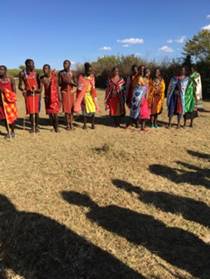
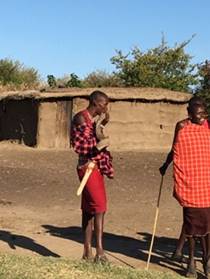
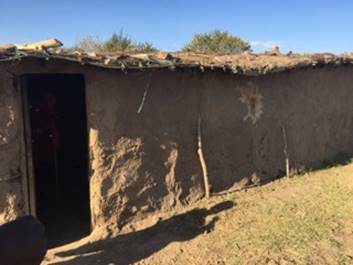
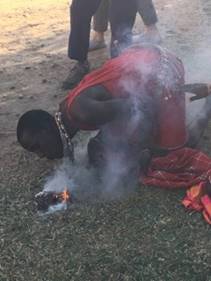
Here's a sampling from the village:
 Entrance of the Maasai (movie)
Entrance of the Maasai (movie)
 Audience Participation (movie)
Audience Participation (movie)
 Doug playing Maasai "horn" (movie)
Doug playing Maasai "horn" (movie)
We fly back on a Dash 8 plane to Nairobi.
19 - End of Safari
We're back in Nairobi at the Eka Hotel. The manager has given us a primo room with a comfortable bed and working A/C, in consideration of our earlier experience two weeks ago. We have the afternoon free to relax and get organized.
The next day we visit the Giraffe Center, which is focused on rescuing the Rothschild Giraffe. They have successfully built the population up from 130 to 1100 giraffes. We get to have a close-up look at them and feed them. Such graceful creatures, with their dreamy eyes and long lashes.
Then over to the Elephant Orphanage which shelters 19 baby elephants that have been abandoned or orphaned. They parade up to their trainers for their milk bottles (or whatever they are) and then cavort in the mud. They're so adorable - playful and mischievous! Lynn has been looking forward to this, as she has adopted one of the elephants, Merru, and hopes to see him. Sure enough, here he comes! It's his first time out, we're told, and Lynn is thrilled.
After lunch we head back to our hotel to pick up our luggage, say our goodbyes, and depart for the trip home.
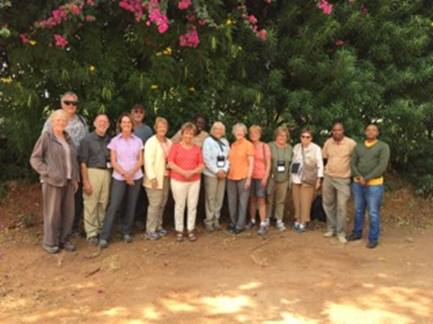
So ends our Africa Chronicle! It's been an amazing trip. It's been everything we hoped for, and more.
Sawa sawa.
